应用化学专业英语lesson22heattransfer
- 格式:ppt
- 大小:3.59 MB
- 文档页数:22
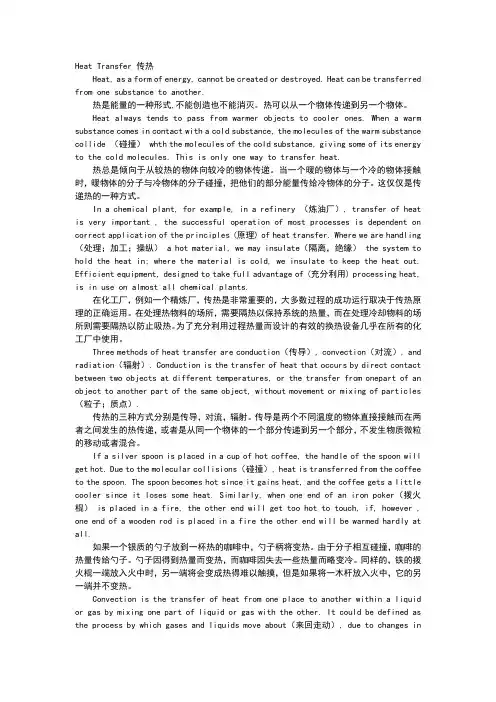
Heat Transfer 传热Heat, as a form of energy, cannot be created or destroyed. Heat can be transferred from one substance to another.热是能量的一种形式,不能创造也不能消灭。
热可以从一个物体传递到另一个物体。
Heat always tends to pass from warmer objects to cooler ones. When a warm substance comes in contact with a cold substance, the molecules of the warm substance collide (碰撞) whth the molecules of the cold substance, giving some of its energy to the cold molecules. This is only one way to transfer heat.热总是倾向于从较热的物体向较冷的物体传递。
当一个暖的物体与一个冷的物体接触时,暖物体的分子与冷物体的分子碰撞,把他们的部分能量传给冷物体的分子。
这仅仅是传递热的一种方式。
In a chemical plant, for example, in a refinery (炼油厂), transfer of heat is very important , the successful operation of most processes is dependent on correct application of the principles (原理) of heat transfer. Where we are handling (处理;加工;操纵) a hot material, we may insulate(隔离,绝缘) the system to hold the heat in; where the material is cold, we insulate to keep the heat out. Efficient equipment, designed to take full advantage of (充分利用) processing heat, is in use on almost all chemical plants.在化工厂,例如一个精炼厂,传热是非常重要的,大多数过程的成功运行取决于传热原理的正确运用。
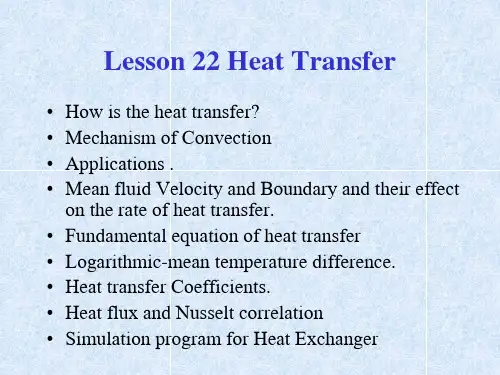
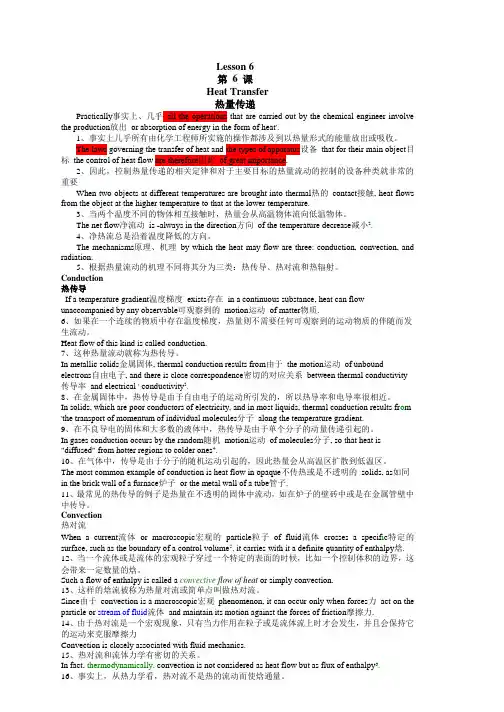
Lesson 6第 6 课Heat Transfer热量传递Practically事实上、几乎all the operations that are carried out by the chemical engineer involve the production放出or absorption of energy in the form of heat'.1、事实上几乎所有由化学工程师所实施的操作都涉及到以热量形式的能量放出或吸收。
The laws governing the transfer of heat and the types of apparatus设备that for their main object目标the control of heat flow are therefore因此of great importance.2、因此,控制热量传递的相关定律和对于主要目标的热量流动的控制的设备种类就非常的重要When two objects at different temperatures are brought into thermal热的contact接触, heat flows from the object at the higher temperature to that at the lower temperature.3、当两个温度不同的物体相互接触时,热量会从高温物体流向低温物体。
The net flow净流动is -always in the direction方向of the temperature decrease减小2.4、净热流总是沿着温度降低的方向。
The mechanisms原理、机理by which the heat may flow are three: conduction, convection, and radiation.5、根据热量流动的机理不同将其分为三类:热传导、热对流和热辐射。
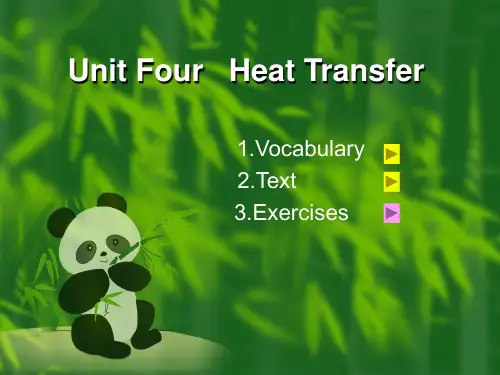
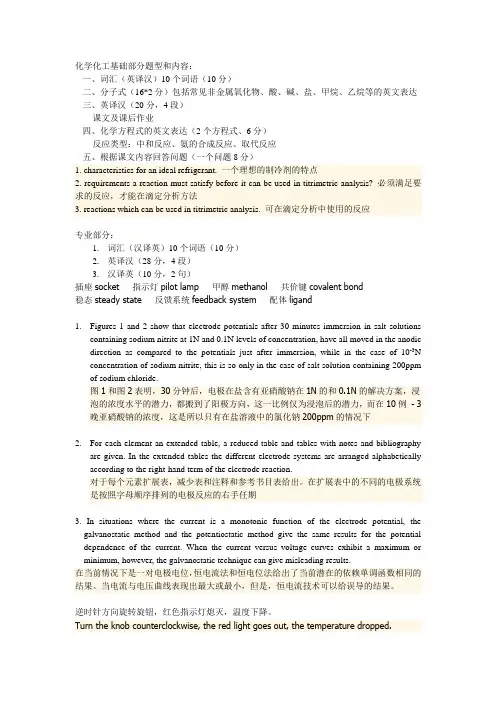
化学化工基础部分题型和内容:一、词汇(英译汉)10个词语(10分)二、分子式(16*2分)包括常见非金属氧化物、酸、碱、盐、甲烷、乙烷等的英文表达三、英译汉(20分,4段)课文及课后作业四、化学方程式的英文表达(2个方程式、6分)反应类型:中和反应、氨的合成反应、取代反应五、根据课文内容回答问题(一个问题8分)1. characteristics for an ideal refrigerant. 一个理想的制冷剂的特点2. requirements a reaction must satisfy before it can be used in titrimetric analysis?必须满足要求的反应,才能在滴定分析方法3. reactions which can be used in titrimetric analysis.可在滴定分析中使用的反应专业部分:1.词汇(汉译英)10个词语(10分)2.英译汉(28分,4段)3.汉译英(10分,2句)插座socket 指示灯pilot lamp 甲醇methanol 共价键covalent bond稳态steady state反馈系统feedback system 配体ligand1.Figures 1 and 2 show that electrode potentials after 30 minutes immersion in salt solutionscontaining sodium nitrite at 1N and 0.1N levels of concentration, have all moved in the anodic direction as compared to the potentials just after immersion, while in the case of 10-3N concentration of sodium nitrite, this is so only in the case of salt solution containing 200ppm of sodium chloride.图1和图2表明,30分钟后,电极在盐含有亚硝酸钠在1N的和0.1N的解决方案,浸泡的浓度水平的潜力,都搬到了阳极方向,这一比例仅为浸泡后的潜力,而在10例- 3晚亚硝酸钠的浓度,这是所以只有在盐溶液中的氯化钠200ppm的情况下2.For each element an extended table, a reduced table and tables with notes and bibliographyare given. In the extended tables the different electrode-systems are arranged alphabetically according to the right-hand term of the electrode reaction.对于每个元素扩展表,减少表和注释和参考书目表给出。
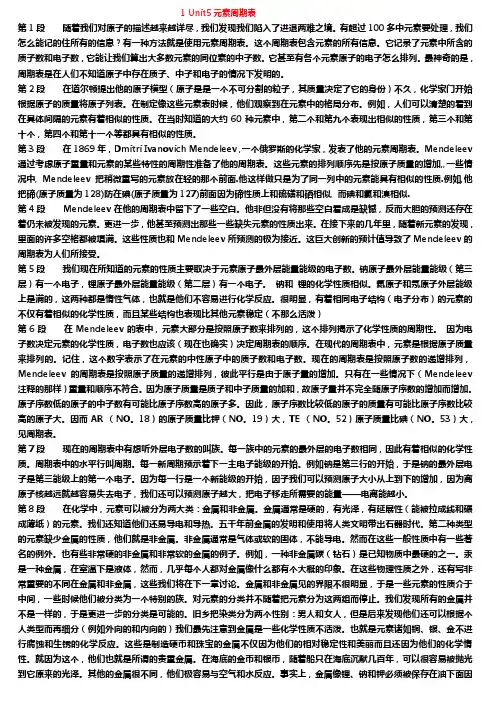
1 Unit5元素周期表第1段随着我们对原子的描述越来越详尽,我们发现我们陷入了进退两难之境。
有超过100多中元素要处理,我们怎么能记的住所有的信息?有一种方法就是使用元素周期表。
这个周期表包含元素的所有信息。
它记录了元素中所含的质子数和电子数,它能让我们算出大多数元素的同位素的中子数。
它甚至有各个元素原子的电子怎么排列。
最神奇的是,周期表是在人们不知道原子中存在质子、中子和电子的情况下发明的。
第2段在道尔顿提出他的原子模型(原子是是一个不可分割的粒子,其质量决定了它的身份)不久,化学家门开始根据原子的质量将原子列表。
在制定像这些元素表时候,他们观察到在元素中的格局分布。
例如,人们可以清楚的看到在具体间隔的元素有着相似的性质。
在当时知道的大约60种元素中,第二个和第九个表现出相似的性质,第三个和第十个,第四个和第十一个等都具有相似的性质。
第3段在1869年,Dmitri Ivanovich Mendeleev ,一个俄罗斯的化学家,发表了他的元素周期表。
Mendeleev通过考虑原子重量和元素的某些特性的周期性准备了他的周期表。
这些元素的排列顺序先是按原子质量的增加,,一些情况中, Mendeleev把稍微重写的元素放在轻的那个前面.他这样做只是为了同一列中的元素能具有相似的性质.例如,他把碲(原子质量为128)防在碘(原子质量为127)前面因为碲性质上和硫磺和硒相似, 而碘和氯和溴相似.第4段 Mendeleev在他的周期表中留下了一些空白。
他非但没有将那些空白看成是缺憾,反而大胆的预测还存在着仍未被发现的元素。
更进一步,他甚至预测出那些一些缺失元素的性质出来。
在接下来的几年里,随着新元素的发现,里面的许多空格都被填满。
这些性质也和Mendeleev所预测的极为接近。
这巨大创新的预计值导致了Mendeleev的周期表为人们所接受。
第5段我们现在所知道的元素的性质主要取决于元素原子最外层能量能级的电子数。
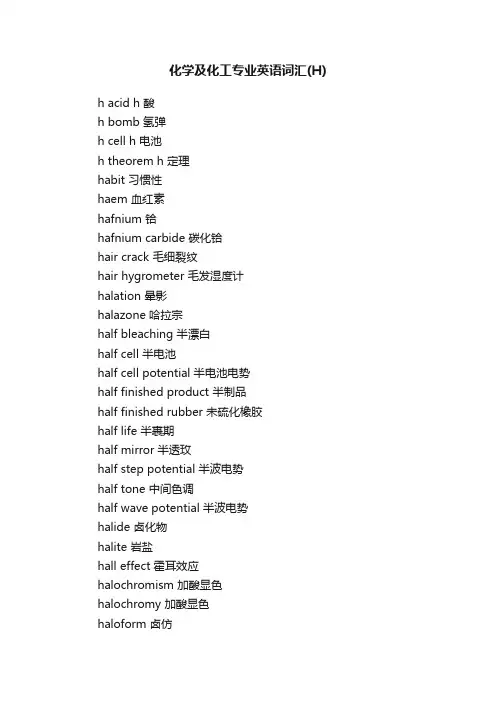
化学及化工专业英语词汇(H)h acid h 酸h bomb 氢弹h cell h 电池h theorem h 定理habit 习惯性haem 血红素hafnium 铪hafnium carbide 碳化铪hair crack 毛细裂纹hair hygrometer 毛发湿度计halation 晕影halazone 哈拉宗half bleaching 半漂白half cell 半电池half cell potential 半电池电势half finished product 半制品half finished rubber 未硫化橡胶half life 半裹期half mirror 半透玫half step potential 半波电势half tone 中间色调half wave potential 半波电势halide 卤化物halite 岩盐hall effect 霍耳效应halochromism 加酸显色halochromy 加酸显色haloform 卤仿haloform reaction 卤仿反应halogen 卤素halogenation 卤化halogenide 卤化物halogeno salt 卤代盐halohydrin 卤代醇halometer 盐量计halometry 盐分测定法halt 停止时间hamiltonian function 哈密顿函数hamiltonian operator 哈密顿算符hammer crusher 锤式破碎机hammer mill 锤式破碎机hand filter press 手工压力过滤器hand furnace 人工炉hand mold brick 手工砖hand picked coal 手选碳hand printing 手工印花hank dyeing 纹纱染色hank printing 纹纱印花hansa yellow 汉萨黄hantzsch synthesis 汉栖合成haptoglobin 亲血色蛋白haptophore 附着簇hard acid 硬酸hard base 硬碱hard burned magnesia 硬烧镁氧hard charcoal 白炭hard coal 无烟煤hard coke 焦炭hard detergent 硬性洗涤剂hard glass 硬玻璃hard metal 硬质合金hard pitch 硬沥青hard porcelain 硬质瓷器hard rubber 硬橡胶hard soap 钠皂hard sphere collision theory 刚性球碰撞理论hard water 硬水hardened filter paper 硬滤纸hardened oil 硬化油hardened rosin 硬化松香hardener 硬化剂hardening 硬化hardening bath 硬化浴hardening solution 硬膜液hardening time 硬化时间hardness 硬度hardness gage 硬度计hardness of water 水的硬度hardness scale 硬度计hardness test 硬度试验hardness tester 硬度试验器hardwood 硬材harman 哈尔满hazardous material 危险物head 水头head temperature 纺丝口温度head to head configuration 头对头结构head to tail configuration 头尾结构head velocity 顶端速度healing 加硫hearth 炉床heat 热heat absorber 吸热器heat accumulator 蓄热器heat balance 热平衡heat capacity 热容heat conduction 热传导heat conductivity 导热系数heat consumption 耗热量heat content 热含量heat control 热控制heat convection 热对流heat cure 干热硫化heat curing 热固化heat distortion 热变形heat effect 热效应heat engine 热机heat equivalent 热当量heat exchange 热交换heat exchanger 热交换器heat function 热函heat hardening 加热硬化heat insulating material 绝热材料heat loss 热损失heat medium 传热介质heat of activation 活化热heat of coagulation 凝结热heat of combustion 燃烧热heat of condensation 冷凝热heat of crystallization 结晶热heat of dilution 稀释热heat of dissociation 离解热heat of dissolution 溶解热heat of evaporation 蒸发热heat of explosion 爆炸热heat of formation 生成热heat of fusion 熔化热heat of hydration 水化热heat of immersion 湿化热heat of ionization 电离热heat of neutralization 中和热heat of reaction 反应热heat of solidification 凝固热heat of sublimation 升华热heat of swelling 膨润热heat of transformation 转变热heat of transition 转变热heat of vaporization 蒸发热heat of wetting 湿化热heat pipe 热导管heat pump 热泵heat quantity 热量heat radiation 热辐射heat recovery 热量回收heat resistance 耐热性heat resistant alloy 耐热合金heat resistant polymer 耐热聚合物heat resistant resin 耐热尸heat resisting coating 耐热涂料heat resisting glass 耐热玻璃heat sensitive paint 示温漆heat source 热源heat test 耐热试验heat transfer 热传递heat transfer coefficient 传热系数heat treatment 热处理heater 加热器heating 加热heating area 加热面积heating curve 加热曲线heating element 发热体heating loss 加热减量heating method of microwave furnace 微波炉加热法heating surface 加热面heatronic molding 高频模塑heavy atom method 重原子法heavy chemicals 化工制品heavy ends 重质馏分heavy hydrogen 重氢heavy ion nuclear reaction 重离子核反应heavy liquid 重液heavy metal 重金属heavy naphtha 重石脑油heavy oil 重油heavy oxygen 重氧heavy water 重水hecogenin 海柯皂苷元hehner number 亥讷值hehner value 亥讷值height per transfer unit 每迁移单位高度helical condenser 旋管冷凝器helicin 水杨醛葡糖甙heliotropin 天芥菜精helium 氦helium cooling 氦冷却helleborein 嚏根草毒苷hematein 苏木因hematin 正铁血红素hematite 赤铁矿hematoporphyrin 血卟啉hematoxylin 苏木精heme 血红素heme synthetase 血红素合成酶hemerythrin 血赤藓素hemiacetal 半缩醛hemicellulose 半纤维素hemicolloid 半胶质hemihydrate 半水合物hemiketal 半酮缩醇hemimorphic crystal 异极晶体hemimorphy 异极象hemin 氯化血红素hemipic acid 半蒎酸hemitropy 半体双晶hemocyanin 血蓝蛋白hemoglobin 血红蛋白hemolysin 溶血素hemolysis 溶血酌hemoporphyrin 血紫质hemopyrrole 血吡咯hemp 大麻hempel gas apparatus 汉培尔气体分析器hempseed oil 大麻子油hendecane 十一烷henry's law 享利定律hentriacontane 三十一烷heparin 肝素heptachlor 七氯heptacosane 廿七烷heptadecane 十七烷heptadecanol 十七烷醇heptanal 庚醛heptane 庚烷heptanoic acid 庚酸heptanol 庚醇heptavalence 七价heptene 庚烯heptose 庚糖heptoxide 七氧化物heptyl alcohol 庚醇heptyl aldehyde 庚醛heptylene 庚烯heptylic acid 庚酸herbicide 除草剂heroin 海洛因hesperidin 橙皮苷hess's law 蒜斯定律heteroatom 杂原子heteroauxin 杂茁长素heteroazeotrope 多相非共沸混合物heterocycle 杂环heterocyclic compound 杂环化合物heterogeneity 不均匀性heterogeneous catalyst 非均相催化剂heterogeneous equilibrium 多相平衡heterogeneous polymerization 非均相聚合heterogeneous reaction 多相反应heterogeneous system 非均相体系heteroion 杂离子heterolysis 异种溶解heterolyte 极性分解质heteronuclear 杂核的heteropolar bond 极性结合heteropolar compound 异极化合物heteropolar crystal 异极结晶heteropolarity 异极性heteropoly acid 杂多酸heteropoly compound 杂多化合物heteropolymer 异质共聚物heterotope 异位素heterotopic faces 异序面heterotrophism 营养异常heterotrophy 营养异常hexachlorobenzene 六氯代苯hexachloroethane 六氯乙烷hexacyanoferrate 铁氰化物hexacyanoferric acid 氰亚铁酸hexadecane 十六烷hexadiene 己二烯hexagonal close packed structure 六角密积结构hexagonal system 六方晶系hexahydrobenzyl alcohol 六氢化苯甲醇hexahydrocresol 六氢化甲酚hexahydropyrazine 六氢吡嗪hexahydropyridine 六氢化吡啶hexahydrothymol 六氢化百里酚hexalin 环己醇hexametaphosphate 六偏磷酸盐hexamethylene 环己烷hexamethylenediamine 己撑二胺hexamethylenetetramine 六甲撑四胺hexanal 己醛hexane 己烷hexanediol 己二醇hexanitrodiphenylamine 六硝基二苯胺hexanoic acid 己酸hexanol 正己醇hexene 己烯hexenol 己烯醇hexogen 黑素金炸药hexokinase 己糖激酶hexonic acid 己糖酸hexosan 聚己糖hexose 己糖hexyl acetate 乙酸己酯hexyl alcohol 正己醇hexylaldehyde 己醛hexylene 己烯hexylic acid 己酸hexylresorcin 己基间苯二酚hide powder 皮粉hiding power 遮盖力high alumina refractory 高铝耐火物high boiler 高沸点化合物high boiling phenols 高沸点石炭酸high density lipoprotein 高密度脂蛋白high density polyethylene 高密度聚乙烯high early strength portland cement 高快固波特兰水泥high elasticity 高弹性high explosive 高级炸药high fermentation 上层发酵high fired porcelain 高温焙烧瓷器high flash solvent 高闪点溶剂high frequency 高频high frequency analyzer 高谐波分析器high frequency coating material 高谐波涂料high frequency concentration meter 高频浓度计high frequency furnace 高谐波炉high frequency heating 高频加热high frequency oscillator 高谐波振荡器high frequency polarography 高谐波极谱法high frequency titration 高频滴定high furnace 高炉high gloss 高度光泽high malecular compound 高分子化合物high performance material 高性能材料high polymer 高分子聚合物high polymer chemistry 高分子化学high polymer ion 高分子离子high pressure 高压high pressure chemical industry 高压化学工业high pressure chemistry 高压化学high pressure compressor 高压压缩机high pressure gas 高压气体high pressure gasifier 高压气体发生炉high pressure plant 高压装置high pressure washing 高压冲洗high purity material 高纯度材料high speed flow 高速流high speed steel 高速钢high temperature carbonization 高温干馏high temperature cracking 高温热分解high temperature tar 高温焦油high vacuum 高真空high vacuum insulation 高真空绝缘higher alcohol 高级醇higher calorific 高发热值higher fatty acid 高级脂肪酸higher homologue 高级同系物higher order reaction 高级反应higher oxide 高级氧化物hindrance 阻碍hippuric acid 马尿酸histamine 组胺histidase 组氨酸酶histidine 组氨酸histochemistry 组织化学histogram 柱式图解hofmann degradation 霍夫曼氏分解hofmann reaction 霍夫曼反应hofmann rearrangement 霍夫曼重排hold up 滞留量hollow article 空心制品hollow brick 空心砖hollow rayon 空心人造丝hollow space radiation 空心辐射holmium 钬holmium chloride 氯化钬holmium hydroxide 氢氧化钬holmium nitrate 硝酸钬holmium oxide 氧化钬holoenzyme 全酶holography 全息照相holohedral form 全面体holohedry 全面体holohyaline 全玻璃质的holomorphic function 全纯函数holosymmetry 全面对称homatropine 后马托品homeomorphism 异质同晶homeopolar compound 无极化合物homochemical compound 二原子化合物homochromic isomer 同色异构体homocycle 同素环homocyclic compound 同素环化合物homogeneity 均一性homogeneous catalysis 均相催化酌homogeneous equilibrium 均相平衡homogeneous ion exchange membrane 均一离子交换膜homogeneous precipitation 均匀沉淀homogeneous reaction 均匀反应homogeneous system 均匀系homogenization of glass 玻璃均化homogenizer 均化器homogentisase 尿黑酶homogentisic acid 尿黑酸homologation 同素化homologous series 同系列homologue 同系物homology 同系现象homolysis 均裂homolytic reaction 均裂反应homophthalic acid 高邻苯二酸homopolar bond 同极键homopolar colloid 同极胶体homopolar compound 同无极化合物homopolymer 均聚物homopolymerization 均聚合homosteroid 高甾类homotropine 升马托品homozeotrope 均匀非共沸混合物hondrometer 粒度计hop 酒花hop resin 酒花尸hopper 料箱漏斗hordenine 大麦芽碱horizontal axis 水平轴horizontal dispersion 水平分散horizontal section 水平断面horizontal tube evaporator 水平管蒸发器hormone 激素horn substitute 角质物horse power 马力hot air cure 热空气硫化hot air sterilizer 干热灭菌器hot air vulcanization 热空气硫化hot atom chemistry 热原子化学hot bath 热浴hot blast 热风hot cure 热硫化hot filter 保温漏斗hot funnel 保温漏斗hot melt adhesive 热熔性胶粘剂hot plate 热板hot press 热压hot setting adhesive 热固胶粘剂hot shortness 热脆性hot strength 热强度hot vulcanization 热硫化hot wire anemometer 热线风速计hot working 热加工household soap 家用皂humectant 湿润剂humic acid 腐殖酸humidification 湿润humidifier 增湿器humidity 湿度humidity drier 可控湿度干燥器humification 腐殖质化humin 腐黑物humulene 蛇麻烯humus 腐殖质hyaluronic acid 透檬酸hyaluronidase 玻璃酸酶hybridization 杂化hybridized orbital 杂化轨道hydantoic acid 海因酸hydantoin 海因hydnocarpus oil 大风子油hydracrylic acid 羟基丙酸hydrargillite 水铝矿hydrastine 白毛莨碱hydrate 水化物hydrated alumina 水合氧化铝hydrated cellulose 水合纤维素hydrated electron 水合电子hydration 水合酌hydration energy 水合能hydrator 水化器hydraulic cement 水硬水泥hydraulic classification 水力离析hydraulic classifier 水力分粒机hydraulic extruder 液压式压出机hydraulic index 水硬系数hydraulic lime 水硬石灰hydraulic module 水硬系数hydraulic modulus 水硬系数hydraulic press 水压机hydraulic radius 水力半径hydraulic separation 水力离析hydraulic test 水力试验hydraulicity 水凝性hydrazine 肼hydrazine sulfate 硫酸肼hydrazinium 肼hydrazo compound 肼基化合物hydrazobenzene 肼撑苯hydrazoic acid 叠氮酸hydrazone 腙hydride 氢化物hydrido complex 氢化络合物hydrizing 氢化酌hydroaromatic hydrocarbon 氢化芳族碳氢化合物hydrobromic acid 氢溴酸hydrocarbon 碳氢化合物hydrocarbons of acetylene series 炔系碳氢化合物hydrocellulose 水合纤维素hydrochloric acid 氢氯酸hydrochloride 盐酸盐hydrochlorination 氯氢化反应hydrocooling 用水冷却hydrocortisone 氢化可的松hydrocracking 加氢裂化法hydrocyclon 水力旋林离器hydrocyclone 水力旋流hydrodealkylation 加氢脱烃酌;加氢脱烷基化hydrodesulfurization 加氢脱硫法;加氢脱硫酌hydrodynamic diameter 铃动力直径hydrodynamics 铃力学hydroextractor 脱水器hydrofining 加氢精制hydrofinishing 氢化精制hydrofluoric acid 氢氟酸hydroforming 临氢重整hydroformylation 烯烃醛化hydrogel 水凝胶hydrogen 氢hydrogen acceptor 受氢体hydrogen arsenide 砷化氢hydrogen bond 氢键hydrogen bromide 溴化氢hydrogen carrier 氢载体hydrogen chloride 氯化氢hydrogen cooling 氢冷却hydrogen cyanide 氰化氢hydrogen donor 氢供体hydrogen electrode 氢电极hydrogen embrittlement 氢脆性hydrogen exponent 氢指数hydrogen halide 卤化氢hydrogen iodide 碘化氢hydrogen ion 氢离子hydrogen ion concentration 氢离子浓度hydrogen peroxide 过氧化氢hydrogen polysulfide 多硫化氢hydrogen salt 氢盐hydrogen storing alloy 氢贮藏合金hydrogen sulfide 硫化氢hydrogen value 氢值hydrogenated fat 氢化脂hydrogenated oil 氢化油hydrogenation 氢化hydrogenolysis 加氢裂化法hydrogenous 富氢的hydroiodic acid 氢碘酸hydrolase 水解酶hydrolysis 水解hydrolysis constant 水解常数hydrolyte 水解质hydrolytic acidity 水解酸性hydrolytic adsorption 水解吸附hydrolytic dissociation 水解离解hydrolytic enzyme 水解酵素hydrolyzate 水解产物hydromechanics 铃力学hydrometallurgy 湿法冶金hydrometer 比重计hydron blue 海昌蓝hydronium ion 水合氢离子hydroperoxide 氢过氧化物hydrophile lipophile balance 亲水亲油平衡hydrophilic 亲水的hydrophilic colloid 亲水胶体hydrophilic group 亲水基团hydrophilization 亲水化hydrophily 亲水性hydrophobic 疏水的hydrophobic bond 疏水键合hydrophobic colloid 疏水胶体hydrophobic group 疏水基hydrophobic hydration 疏水性水合hydrophobic interaction 疏水性相互酌hydrophobing 疏水酌hydrophobization 疏水化hydroquinone 氢醌hydroquinone dimethyl ether 对苯二酚二甲醚hydrosilicate 含水硅酸盐hydrosilylation 氢化硅烷化hydrosol 水溶胶hydrostatic head 静水压头hydrosulfide 氢硫化物hydrothermal crystal growth 热液晶体生长hydrothermal synthesis 热液合成法hydrotimeter 水硬度计hydrotimetry 水硬度测量术hydrotropy 助溶性hydrous 含水的hydroxamic acid 氧肟酸hydroxide 氢氧化物hydroxy acid 羟基烃酸hydroxy compound 羟基化合物hydroxy fatty acid 羟基脂肪酸hydroxyaldehyde 羟醛hydroxyalkanoic acid 羟基烃酸hydroxyamino acid 羟基氨基酸hydroxybenzoic acid 羟基苯酸hydroxycarboxylic acid 羟基烃酸hydroxyketone 羟基酮hydroxyl ion 羟离子hydroxyl value 羟值hydroxylamine 羟胺hydroxylamine hydrochloride 盐酸羟胺hydroxylation 羟基化hydroxyproline 羟基脯氨酸hydroxyquinoline 羟基喹啉hydroxysalt 羟盐hydroxysuccinic acid 苹果酸hydrozincite 水锌矿hygrograph 自记湿度计hygrometer 湿度计hygrometry 测湿法hygroscopic 吸湿的hygroscopic depression 吸湿性降低hygroscopic equilibrium 吸着水平衡hygroscopic moisture 湿存水hygroscopicity 吸湿性hygrostat 恒湿器hymecromone 羟甲香豆素hyoscyamine 天仙子胺hyperbolic function 双曲线函数hyperchrome 增色团hyperchromic effect 增色效应hyperchromicity 增色性hyperconjugation 超共轭hyperfine structure 超精细结构hyperfine structure of spectral line 光谱线超精细结构hypergol 自燃火箭燃料hyperoxide 过氧化物hypersensitization 超增感hypertonic solution 高渗溶液hypnotoxin 催眼毒素hypoboric acid 连二硼酸hypochlorite 次氯酸盐hypochlorite titration 次氯酸盐滴定hypochlorous acid 次氯酸hypochlorous acid anhydride 次氯酸酐hypochromic effect 浅色效应hypochromicity 减色性hypoiodite 次碘酸盐hypometamorphism 亚变质酌hyponitric acid 过氧化氮hyponitrous acid 连二次硝酸hypothesis 假说hypotonic solution 低渗压溶液hypsochromic effect 色光变浅效应hysteresis 滞后hysteresis loss 滞后损失hysterocrystallization 次生结晶酌。

U n i t1T h e R o o t s o f C h e m i s t r yI. Comprehension.2. B3. D4. C5. BII. Make a sentence out of each item by rearranging the words in brackets.1.The purification of an organic compound is usually a matter ofconsiderable difficulty, and it is necessary to employ various methods for this purpose.2.Science is an ever-increasing body of accumulated and systematizedknowledge and is also an activity by which knowledge is generated.3.Life, after all, is only chemistry, in fact, a small example of chemistryobserved on a single mundane planet.4.People are made of molecules; some of the molecules in people are rathersimple whereas others are highly complex.5.Chemistry is ever present in our lives from birth to death because withoutchemistry there is neither life nor death.6.Mathematics appears to be almost as humankind and also permeates allaspects of human life, although many of us are not fully aware of this. III. Translation.1. a chemical process b natural science c the technique of distillation2.It is the atoms that make up iron, water, oxygen and the like/and so on/andso forth/and otherwise.3.Chemistry has a very long history, in fact, human activity in chemistrygoes back to prerecorded times/predating recorded times.4.According to/From the evaporation of water, people know/realized thatliquids can turn/be/change into gases under certainconditions/circumstance/environment.5.You must know the properties of the material before you use it.IV. Translation化学是三种基础自然科学之一,另外两种是物理和生物;自从宇宙大爆炸以来,化学过程持续进行,甚至地球上生命的出现可能也是化学过程的结果;人们也许认为生命是三步进化的最终结果,第一步非常快,其余两步相当慢;这三步是:I物理进化化学元素的产生,II化学进化分子和生物分子的形成;和III生物进化有机物的形成和发展;V. Solution:1The relative mass of 1H and 12C atoms can be calculated from their absolute masses in grams.If the mass of a 12C atom is exactly 12 amu,then the mass of a 1H atom to five significant figures must be amu.12 amu x = amu2First we calculate k and then use the first-order rate equation.The bone was tossed away more precisely, the animal whose bone was died about 6100 years ago, or about 4100 . We can thus be sure that a village was in existence at that place at that time.Unit 7 The Nomenclature of Inorganic SubstancesI. ComprehensionII. Give the systematic name for the followingammonium ion ; copperII ion ; strontium ion;CcopperI ion; ironII ion; zinc ion;hydrogen ion; leadII ion; aluminum;silver ion; magnesium ion; chromiumIII ion;Barium ; ManganeseII ion; ironIII ion;calcium ion; mercuryII ion;chromiumII ion; tinII ion.carbon monoxide; ditrogen trioxide;carbon dioxide; diphosphorus pentoxide;sulfur trioxide; dichlorine heptoxidearsenate ion; sulfite ion; hydride ion;arsenite ion; bromide ion; hydroxide ion;phosphate ion; chlorate ion; hypochlorite ion;phosphate ion; chloride ion; iodate ion;carbonate ion; chlorite ion; nitrate ion;chromate ion; cyanide ion; iodide ion;dichromate ion; fluoride ion; nitrate ion;oxide ion; hydrogen carbonate ion; nitrite ion;sulfide ion; hydrogen sulfate ion; perchlorate ion;sulfate ion; hydrogen sulfite ion; permanganate ion.name of the acid ion negative ion. Use the rule to give the name of theof the sentence.altered; illustrate expect cancel6. are pulled on ; referred discussedVI. Translation1. Matter can neither be created nor be destroyed/eliminated.2. It is necessary that a scientist must know how to use fingures to get an accutate answer to question.3. Any substance is made of atoms whether it is solid, liquid or gas.4. The experiment was successful. It’s results was the same as what we had expected.5. It will not be long before we finish the experiment.VII. Write equations for the following acid-base reactions. Use the information in inorganic textbook to predict whether the equilibrium will favor the reactants or the products. Partially SolvedSolutin to a: Cyanide is the conjugate base of HCN. It can accept a proton from formic acid:Reading from inorganic textbook, formic acid p K a= is a stronger acid than HCN p K a=, and cyanide is a stronger base than formate. The products weaker acid and base are favored.…………..VIII. Write equations for the net reactions which occur when the following materials are added to a sodium-ammonia solution.Answer: 1 2CH3GeH3+ 2eam-→ H2+ 2CH3GeH2-2 I2 + 2eam-→ 2I-3 C2H52S + 2eam- + NH3→ C2H5S- + C2H6+ NH2-Unit 10 Nomenclature of HydrocarbonsI. ComprehensionV. Each of the following names is incorrect. Draw the structure represented by the incorrect name or a consistent structure if the name is ambiguous, and give your drawing the correct name.…………Unit 11 Carboxylic Acids and Their DerivativesI. ComprehensionII. Fill in the blanks with the phrases given below.out or so; put together made of ;divided by different from the contrary; consist of up for as ; dependent on down intoIII. Put in proper prepositions or adverbs into the blanks.; asIV. Translation1. Similarly, solvent also may not be liquid matter but the others2. A graph plotting solubility against temperature is called a solubility curve.The curve plot drawn made / produced by solubility as one coordinate and temperature as another coordinate is called solubility curve.3. Air is mixture of gases , the most abundant of which is nitrogen in themolecules.form of N24. The direction of the reaction and the position of the equilibrium may also be affected by the temperature, pressure, and other conditions.5. Hydrogen has a great affinity for oxygen and easily combines with it to form water.V. Translation玻意尔Bohr模型提出不久后,人们就发现原子中的电子比Bohr提出的模型要复杂得多;实验证实电子既有粒子的性质质量也有光的特性波的特性;因为它的两重性,电子不能被看作是在确定范围内绕核旋转的一种简单粒子,而且如Bohr所说的,如果电子高速运动,我们就不能确切地知道它的位置;Unit 13 Ultraviolet and Visible Molecular SpectroscopyI. ComprehensionII. Fill in the blanksof; as; in; out; In; for; for ; of; in; then; to; for;sincefor ; into. III. Fill the blank in each sentence with an appropriate phrase in its proper form.1. account for part in of ….as compared with5. is attached to the contrary in the case of contrast with as against 9. owing to for.Unit 17 CrystallisationI. ComprehensionII. Fill in the blanks with the proper word given below.Stage; interna; symmetrical; basis; physical; Furthermore; composed; responsible; reasonable; overall.III. Choose the item from 1 ~ 6 that best matches the item ina ~ f to makea correct sentence.1~a; 2~b; 3~c; 4~d; 5~e; 6~fthe following into Chinese共沸物;类质同晶;过饱和;砷酸盐;晶核;异丙基;醇;钠;硫酸盐;间甲酚;糖膏;十水合物;结晶质的;同系物;衍生物;结晶;四硼酸盐;盐析;乙基乙酰苯胺;矿物油;Uint18 DistillationI. Comprehension4. AII. Fill in the blanks with the phrases given below.order to relation to 3. in the case of the end5. in a number of to messy way掌握以下词汇:flashdistillation闪蒸 ;exit stream出流 ;e quilibrium curve 平衡曲线; weir堰; redistillation 重蒸; apparatus 设备;overhead product塔顶产物; enthalpy焓; intersection 交点; auxiliary辅助装置; rectifying section精馏段 ;reflux回流; reboller 再沸器; stripping section 汽提提馏段;bottom product 塔底产物Unit 21 catalysisI. Comprehension4. BIV. Translate the following sentences into English1 We define activity as size measure of catalysis of catalyst2 catalytic reaction may be carried out in different phases, of which mechanisms are generally consistent3 Enzymes are the most efficient proteinsin the human body which accelerate the metabolism of the human body.V. Translate the following into Englishreaction equilibrium; repetitiveness; elementary reaction step; stability; catalytic cycle; activity; quantitative analysis; selectivity;metabolic reaction; chemical energy; reaction mechanism; polymer nylonor nylon;qualitative analysis; molecular-sieve; tubular reactor; inhibitor; stoichiometry.Unit 22 Cosmetics introductionI. Comprehension4. D5. 1True; 2True; 3 False.II. Fill in the blanks with the proper word given below.Focused on; considerations; particular; boosting; price; affect; commitment;different; proposed.III. Put in proper prepositions or adverbs into the blanks.1. for, of;2. to;3. for4. forto5. of ,about.V、Translate the following into English.对亚苯基二胺,降解,丙烯,头皮屑,洗剂, N-亚硝基二乙醇胺,致癌的, 未成熟or早熟,香波or洗发剂, 激素荷尔蒙, 防汗剂, 诱变性, 脱臭剂芳香剂, 推论必然结果, 甘油VI、Translate the following sentences into Englishsurfactant;environmental pollution;emulsifier;side-effect;dirt;detergent; perspiration;preservative.PART TWO THE FUNDATIONS OF CHEMISTRYUnit7Chemical Bonds化学键There are approximately 100 chemical elements.世界上大概有100种元素;There are millions of chemical compound, and about 600000 new compounds are prepared every year.现有数百万种化合物,而且每年有60万种新化合物被合成出来;To form these compounds, atoms of different elements must be held together in specific combinations.be held togetherin specific combinations 以特定的方式为了合成这些化合物,不同种类的原子必须以特定方式结合在一起;Chemical bonds are the forces that maintain these arrangements.That引导定语从句,修饰forces化学键是保持这种结合状态的力;Chemical bonding also plays a role in determining the state of matter.plays a role 起作用化学键同时在决定物质状态方面也起作用;At room temperature, water is a liquid, carbon dioxide is a gas, and table salt is a solid because of differences in chemical bonding.在室温下,水是液体,二氧化碳是气体,晶体盐是固体,是由于化学键的不同;As scientists developed an understanding of the nature of chemical bonding, they gained the ability to manipulate the structure of compounds.As引导原因状语从句to manipulate the structure of compounds不定式短语做宾补随着化学家对化学键认识的发展,他们获得了控制化合物结构的能力;Dynamite, birth control pills, synthetic fibers, and a thousand other products were fashioned in chemical laboratories and have dramatically changed the way we live.炸药、避孕药、合成纤维,和数以千计的其他产品在实验室中被合成出来,并且魔术般的改变了我们的生活;We are now entering an era that promises some would say forebodes even greater change.我们现在进入了一个可望或者说预言更大变化的时代;The DNA molecular——the chemical basis of heredity—— carries its genetic message in its bonds in DNA.分子DNA——遗传物质的基础——以它的键传递遗传信息;Whether an organism is fish, fowl, hippopotamus, or human is determined by the arrangement of bonds in DNA.Whether an organism is fish, fowl, hippopotamus, or human 做主语无论一个生物体是鱼、家禽、河马还是人,都是由于DNA的键的组合方式决定的;Scientists already have the ability to rearrange these bonds, and this ability has given them limited control over the structure of living matter.Them, limited control over the structure of living matter 双宾语科学家已经获得了重组这些键的能力,而这种能力给了他们有限的对生物体结构的控制;As techniques of genetic engineering improve, scientists may literally be able to custom-tailor genes.随着基因工程的发展,科学家们将最终设计出符合条件的基因;Let us begin our consideration of chemical bonding so that we, too, can understand the forces that control the structure of matter, living and nonliving.That引导定语从句修饰forces,living and nonliving,动名词,matter得同位语,修饰matter 让我们开始对化学键的论述,并由此理解控制物质,包括有生命体和无生命体,的结构的力;Ionic Bond 离子键Let us look at an atom of the element sodium Na.我们看一下钠原子;It has 11 electrons, of which two are in the first energy level, eight in the second, and one in the third.the first energy level第一能级the second energy level第二能级the third energy level第三能级It has 11 electrons, of which two are in the first energy level, eight are in the second energy level, and one is in the third energy level.它有11个电子,其中2个电子在第一能级,8个电子在第二能级,1个电子在第三能级;If the sodium atom could get rid of an electron, then the product, called a sodium ion, would have the same electron structure as an atom of the noble gas neon Ne.called a sodium ion分词短语做非限定,修饰productnoble gas如果钠原子能够失去1个电子,产物称为钠离子,就和惰性气体氖Ne具有相同的电子结构;Let us immediately emphasize that the sodium ion Na+ and neon atom Ne are not identical.让我们首先强调一下,钠离子Na+和氖原子Ne并不相同;The electron arrangement is the same, but the nuclei——and resulting charges—— are not.electron arrangement 电子排布resulting charges最终电荷电子排布是相同的,而核及最终电荷是不同的;As long as sodium keeps its 11 protons, it is still a form of sodium, but it is the sodium ion, not the sodium atom.只要钠带有11个质子,它就一直是钠,但它是钠离子而不是钠原子;Ions are charged particles, particles in which the number of electrons does not equal the number of protons.in which 引导非限定定语从句;离子是一种带电粒子,一种电子数不等于质子数的粒子;Positively charged ions are called cations pronounced “cat-ions”. The sodium ion is a cation.带正电荷的粒子称为阳离子音为阳-离子;钠离子是阳离子;If a chlorine atom Cl could gain an electron, it would have the same electron structure as the noble gas argon Ar.如果氯原子Cl能够得到一个电子,它将与惰性气体氩Ar具有相同的电子结构;The chlorine atom, having gained an electron, becomes negatively charged. It has 17 protons 17+ and 18 electrons 18-. It is written Cl- and it called a chloride ion.having gained an electron动名词形式做定语,修饰chlorine atom获得一个电子的氯原子带有负电荷;它具有17个质子17+和18个电子18-,写作Cl-,称为氯离子;Negatively charged ions are called anions pronounced “ann-ions”. The chloride ion is an anion.带负电荷的粒子称为阴离子音为阴-离子;钠离子是阴离子;A sodium forms a less reactive species, a sodium ion, by losing an electron.a less reactive species, a sodium ion同位语钠原子通过失去一个电子形成不活泼的钠离子;A chlorine atom becomes a less reactive chloride ion by gaining an electron.氯原子通过得到一个电子形成不活泼的氯原子;A chlorine atom cannot just pluck an electron from empty space, nor can a sodium atom kick out an electron unless something else is willing to take it on.empty space 空白空间、真空空间,意为“凭空”、“无根据”nor作连词,与助动词和情态动词连用,句中主语与动词倒置;He can’t see, nor could he hear until a month ago. 他现在看不见,一个月之前他还听不见;She isn’t rich, nor do I image that she ever will be. 她现在不富,我看她将来也富不了;kick out 逐出、解雇、开除;意为“失去”They kicked him out of the club for fighting.他因为斗殴而被开除出俱乐部;something else 别的东西take … on 接纳、承受氯原子不能凭空获得一个电子,而钠原子也不能凭空失去一个电子,除非别的东西愿接受电子;What happens when sodium come into contact with chlorine The obvious. A chlorine atom removes an electron from a sodium atom.come into contact 接触、相遇The obvious 显而易见的当钠与氯接触时发现了什么很明显,氯原子从钠原子处拿走了一个电子;The sodium ion and the chloride ion have electron arrangement s electron configurations like those of two noble gases neon and argon, respectively.electron arrangement电子排布electron configurations电子结构钠离子和氯离子的电子排布电子结构就象两个惰性气体氖和氩,相应的一样;Not only do the ions have stable octets of electrons, they also have opposite charges.它们具有稳定的电子八耦体结构,而且有相反的电荷;Everyone knows that opposites attract.每个人都知道异性相吸;While this rule of thumb may not always work when applied to people, it works quite well for cations and anions.rule of thumb单凭经验来做的方法,比较粗糙的方法,约略得衡量或估计虽然这种经验对人未必适用,但对阴阳离子是非常适用的;The attractive force between oppositely charged ions is called an ionic bond, and the combination of sodium ions and chloride ions is the compound sodium chloride or table salt.相反电荷之间的吸引力称为离子键,钠离子和氯离子结合为化合物氯化钠和食盐;Covalent Bonds共价键One might expect a hydrogen atom, with its one electron, to acquire another electron and assume the helium configuration.to acquire another electron and to assume the helium configuration不定式做宾补人们也许希望带有一个电子的氢原子,获得另一个电子并呈现氦的结构;Indeed, hydrogen atom do just that in the presence of atoms of a reactive metal such as lithium, that is, a metal that finds it easy to give up an electron.do代替上句, just that引导条件状语reactive metal活泼金属that is 插入语,也就是说a metal,reactive metal的同位语,that引导定语从句修饰a metal实际上,氢原子只有在活泼金属如锂的存在下确实发生了这样的反应,活泼金属就是很容易失去电子的金属;But what if there are no other kinds of atoms around但是,如果周围没有其他种类的原子呢What if there are only hydrogen atoms as in a sample of the pure element如果只有氢原子作为纯元素样品呢One hydrogen atoms can scarcely grab an electrons from another, for among hydrogen atoms all have equal attraction for electrons Even more important, perhaps, hydrogen atoms do not have a tendency to lose electrons at all, for the result would be a highly reactive bare proton—— the hydrogen nucleus.Even more important更重要的一个氢原子几乎不能从另一个氢原子处获取电子,因为氢原子具有相同的电子吸引力更重要的,可能是,氢原子没有失去电子的倾向,因为那样的结果是生成高度活泼的裸露质子——氢原子核;Still—— hydrogen wants a duet of electrons like helium’s.而且——氢原子希望象氦原子那样拥有2个电子;If one hydrogen cannot capture another’s electron, the two atoms can compromise by sharing their electrons.如果一个氢原子不能获取另一个氢原子的电子,这两个原子则通过共用电子的方式解决;It is as if the two hydrogen atoms, in approaching one another, get their electron clouds or orbitals so thoroughly enmeshed that they cannot easily pull them apart again.in approaching one another 做插入语as if与as though 用法相同,意为:宛如、仿佛、好像;as if 后面常用过去时表示现在,说明所作的比较“不是真的”;You look as if you’d seen a ghost.在非正式文体中,常用like代替as if; He sat there smiling like it was his birthday.就好像两个氢原子,当它们互相接近时,其电子云充分重叠,以至于难于再分开;Moat of the time the electrons are located between the two nuclei.大部分时间电子位于两个原子之间;The electron-dot formula usually used, H:H, is therefore a fairly good picture If we were to attribute human qualities to hydrogen atoms, we would suggest that they are a bit nearsighted. Each one look s around, see s two electrons, and decide s that these electrons are its very own and that therefore it has as arrangement like that of helium, one of the noble gases.electron-dot formula 电子式noble gase惰性气体经常用电子式H:H表示,这是一个很好的画面如果我们以人的品性归于氢原子,我们说它们有些目光短浅;每个氢原子看看周围,看到两个电子,就认为这些电子是自己的,它们就有了象惰性气体氦那样的电子排布;This combination of hydrogen atoms is called a hydrogen molecule.这种氢原子化合物叫氢分子;Molecules are discrete groups of atoms held together by shared pairs of electrons. The bond formed by a shared pair of electrons is called a covenlent bond.分子是通过共用电子对将两个分离的原子结合在一起;通过共用电子对形成的键称为共价键;A chlorine atom will pick up an extra electron from anything willing to give one up.氯原子可以从任何愿意失去一个电子的原子处得到一个电子;But, again, what if the only thing around is another chlorine atom但是,如果周围只有另一个氯原子又会怎样Chlorine atoms, too, can attain a more stable arrangement by sharing a pair of electrons.氯原子同样也是通过共用电子对达到稳定结构;Each chlorine atom in the chlorine molecule counts eight electrons around itself and concludes that it has an arrangement like that of the noble gas argon.that it has an arrangement like that of the noble gas argon.宾语从句氯分子中每个氯原子周围都有8个电子,并且可以断定它具有惰性气体氩一样的排布;The shared pair of electrons in the chlorine molecule also creates a covalent bond.氯分子中共用的一对电子同样形成共价键;For simplicity, the hydrogen molecule is often represented as H2 and the chlorine molecule as Cl2.the chlorine molecule as Cl2:the chlorine molecule is often represented as Cl2为了简化,氢分子常写成H2,氯分子常写成Cl2;The subscripts indicate two atoms per molecule.这个下标表示每个分子中有2个原子;In each case, the covalent bond between the atoms is understood. Sometimes the covalent bond is indicated by a dash, H-H and Cl-Cl.在每种情况下,原子之间的共价键都可以理解,有时共价键也用一个短线表示H-H和Cl-Cl;:Let us be sure we understand the meaning of numbers in formulas.让我们确信我们理解公式中数字的意义;Take a moment to establish in your mind the difference among the following: H,H2,2H,2 H2,H2O,2 H2O.花点时间来搞清楚下面数字的不同:H,H2,2H,2 H2,H2O,2 H2O;Is it clear to you that although H represents a single atom of hydrogen, H2implies two atoms of H bonded together, whereas 2H represents two separate, free, and independent atoms of H That引导实际主语你是否明白H代表分离的氢原子,H2代表两个H结合而成的氢分子,而2H代表分离的、自由的、孤立的氢原子吗On the other hand, the meaning of H2 in H2O is totally different from that of H2 as a molecule.另一方面, H2在H2O中的意思与作为一种分子的H2完全不同;In H2O it means that two atoms of H are individually attached to Onot to themselves to form a molecule of water.在 H2O中表示两个H分别吸引O而不是它们自己来形成一个水分子;Finally, 2 H2O simply refers to two individual molecules of water.最后,2 H2O代表两个独立的水分子;Covalent bonds are not limited to the sharing of one pairof electrons. Consider, for example, the nitrogen atom. Its electron-dot symbol is :N .....共价键不限于分享一对电子;例如,对于氮原子;它的电子式是:N ..... Now, after all we have learned about the octet rule we knowthat this electron arrangement is not complete.octet rule 八耦体规则现在,我们学习了八耦体规则;我们知道这个电子排布是不饱和的;It has only five electrons in its outermost energy level .outermost energy level 外层电子能级在它的外层电子能级上只有5个电子;It could shared a pair of electrons with another nitrogen atom and would then look like this :N ...:::N . 它可以与另一个氮原子共用一对电子而变成如下形式:N ...:::N .The situation has not improved a great deal.情况并没有发生太大变化;Each nitrogen atom in this arrangement has only sixelectrons surrouding it not eight.每个氮原子周围电子排布只有6个电子不是8个;Each nitrogen atom has two electrons hanging out therewithout partners, so, to solve the dilemma, each nitrogen atomshares two additional pairs of electrons, for a total of three pairs.hanging out把…伸出、挂出,上身伸出窗外,闲荡每个氮原子都有两个未成对电子,所以,为了解决这一矛盾,每个氮原子共用另外两对电子,共3对电子In drawing the nitrogen molecule N2, we have placed all the electrons being shared by the two atoms in the space between the two atoms.being shared by the two atoms分词短语做定语写氮分子N2时,我们把两个原子的所有的共用电子都写在两个原子中间;Each nitrogen atom has now satisfied the octet rule.每个氮原子都满足了八耦体规则;A molecule in which three pairs of electrons a total of six individual electron are being shared is said to contain a triple bond.in which three pairs of electrons a total of six individual electron are being shared定语从句triple bond三键一个分子共享三对电子共6个单个电子被称为含有三键;Each nitrogen atom also has an unshared pair of electrons.每个氮原子还含有一对孤对电子;Note that we could have drawn the unshared pair of electrons above or below the atomic symbol.atomic symbol 元素符号注意我们可以把孤对电子写在元素符号的上方或下方;Such a drawing would represent the same molecule.这些写法代表相同的分子;Polar Covalent Bonds 极性共价键So far we have seen that atoms combine in two different ways.So far迄今为止,就此范围或程度说来迄今为止,我们看到了两种不同的原子结合方式;Some that are quite different in electron structure from the opposite ends of the periodic table react by the complete transfer of one or more electrons from one atom to another ionic bond formation.from the opposite ends of the periodic table周期表相对的两端句子结构:some……react by……Transfer 名词那些原子结构截然不同周期表左右两端的原子,一个将一个或数个电子由一个原子完全传递到另一个原子的方式反应离子键形成;Atoms that are identical combine by sharing one or more pairs of electrons covalent bond formation.相同的原子通过共用一对或多对电子共价键形成而结合;Now let us look at some “in-betweeners”.现在让我们看一下“居于中间者”;Hydrogen and chlorine react to form a colorless, toxic gas called hydrogen chloride.hydrogen chloride 氯化氢氢与氯反应生成一种无色、有毒的气体氯化氢;This reaction can be represented schematically by这个反应可由下式表示:H + Cl → HCl 或H-ClBoth the hydrogen atom and the chlorine atom want an electron, so they compromise by sharing and form a covalent bond.氢原子和氯原子都想得到一个电子,所以它们通过共用电子对结合并形成共价键;Since the substances hydrogen and chlorine actually consist of diatomic molecules rather than single atoms, the reaction is more accurately represented by the scheme.diatomic molecules 二原子分子由于氢和氯实际上是二原子分子而不是单个原子,反应写成下式更准确This can be more simply written as简写为H2+ Cl2→ 2HClOne might reasonably ask why the hydrogen molecule and the chlorine molecule react at all.有人也许会问为什么氢分子和氯分子能够完全反应;Have we not just explained that they themselves were formed provide a more stable arrangement of electrons宾语我们不是已经解释了它们本身形成了相对稳定的电子排布了吗Yes, indeed, we say that. But there is stable and there is more stable.是的,我们说过这些,但这有稳定和更稳定;The chlorine molecule represents a more stable arrangement than separate chlorine atoms, but, given the opportunity, a chlorine atom would rather bond to hydrogen thanbond to another chlorine atom.would rather……than含有选择得意思,“宁可……而不……”would rather与than后面为平行结构氯分子代表着比单独的氯原子更稳定的排列,但是,若有机会,氯原子宁可与氢成键而不愿与另一个氯成键;In a molecule of hydrogen chloride, a chlorine atom shares a pair of electrons with a hydrogen atom.在氯化氢分子中,氯原子和氢原子共用一对电子;In this case, and in others we shall consider, sharing does not mean sharing equally.在这种情况下,以及我们能想到的其他情况,共用并不意味着完全分享;Some atoms within molecules attract electrons more strongly than do other atoms.分子中一些原子吸引电子的能力比其他原子强;The term electronegativity is used to describe the affinity of an element in a molecule for electrons.电负性是用来描述分子中原子的亲和力的;The higher the electronegativity, the more strongly the atoms of an element attract electrons to themselves.电负性越大,原子吸引电子的能力越强;The most electronegativity element is fluorine, which is located in the upper right corner of the periodic table.电负性最大的元素是氟,它处于元素周期表的右上角;The electronegativity of elements decreases as one moves away from fluorine in the periodic table.在周期表中,离氟越远,元素的电负性越弱;Thus electronegativity decreases as one moves down a group column or left across a period row.down a group column 由族列向下left across a period row 由周期行向左所以,由族列向下或由周期行向左,电负性减弱;I. Comprehension1. What is the main idea of the paragraph AA. There are so many kinds of chemical bonds.B. How does the ionic bond come into being.C. The noble gases are stable.D. Can sodium atoms and chlorine atoms react with each otherto form a stable arrangement of electrons.2. What is the author’s meaning by saying “even atoms havetheir own standards of beauty” BA. Atoms can detect whether an electron arrangement isbeautiful or not.B. There are standards or rules that can determine if an electron arrangement is favored or not.C. Atoms are more favored a beautiful electron arrangementthan an ugly one.D. We can beautify atoms by their standards.3. What’s “the standards of beauty” of atoms CA. An octet eight outer electrons.B. A duet two outer electrons.C. A and B.D. There is no such standards.4. Are the sodium ion Na+and the neon atom Ne identical EA. Yes, they have same electron numbers.B. Yes, they have same electron arrangement.C. No, sodium ion is still a form of sodium, not atom but cations.D. No, sodium ion is a charged particle, while the neon atomis a neutral one.E. C and D.5. It is impossible for Tom to judge such important affairBA. as a rule of thumb.B. by rule of thumb.C. though a rule of thumb.D. by experiment.6. What happens during Na + Cl Na+Cl- DA. the nuclei of each ions are changed.B. the inner energy level of electrons changed.C. A and B.D. The outermost energy level is altered.7. Is there any order or any pattern to the way that theelectron dot are draw CA. No, there is no any order.B. Yes, the p orbitals are filled firstly.C. Yes, the s orbital is filled firstly and the p orbitals.D. Yes, but the p orbitals is filled willfully.V. TranslationChlorine is more electronegative than hydrogen. In a hydrogen chloride molecule, the chlorine atom has a much greater attraction than the hydrogen atom for the shared electron pair. Because the shared electron are held more tightly by the chlorine atom, the chlorine end of the molecule is more negative than the hydrogen end. If you think of an orbital as a fuzzy-looking cloud, then the cloud is denser near the chlorine atom. When the electrons in a covalent bond are not equally shared, the bond is said to be polar. Thus the bonding in hydrogen chloride is described as polar covalent. Whereas the bonding in the hydrogen molecule or in the chlorine molecule in nonpolar covalent. The polar covalent bond is not an ionic bond. In an ionic bond, one atom completely losed an electron. In a polar covalent bond, the atom at the positive end of the bond hydrogen in HCl still gas some share in the bonding pair of electrons. To distinguish this arrangement from that in an ionic bond, the following notation is use.The line between the atoms represents the covalent bond, a pair of shared electrons. The δ+ and δ- signify which end is partially positive and which is partially negative the word partially is used to distinguish this charge from the full charge on an ion.。
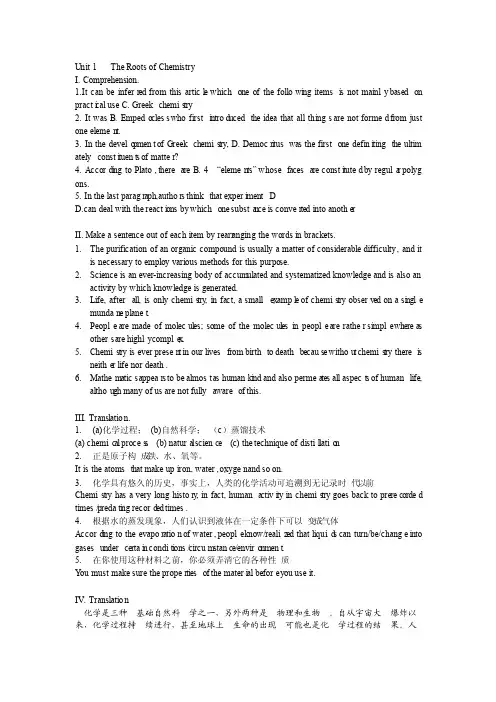
Unit 1 The Rootsof Chemis tryI. Compre hensi on.1.It can be inferred from this articl e whichone of the followi ng itemsi s not mainly basedon practi c al use C. Greekchemis try2. It was B. Empedo cless who firsti ntrod ucedthe idea that all things are not formed from just one elemen t.3. In the develo pment of Greekchemis t ry, D. Democri tus was the first one defini tingthe ultimatelyconsti tuent s of matter?4. Accord i ng to Plato, thereare B. 4 ―elemen ts‖ whosefacesare consti tuted by regula r polygons.5. In the last paragraph,authors thinkthat experi ment DD.can deal with the reacti ons by whichone substa n ce is converted into anothe rII. Make a senten ce out of each item by rearra nging the wordsin bracke ts.1.The purifi catio n of an organi c compou nd is usuall y a matter of consid erabl e diffic ulty, and itis necess ary to employ variou s method s for this purpos e.2.Scienc e is an ever-increa singbody of accumu lated and system atize d knowle dge and is also anactivi ty by whichknowle dge is genera ted.3.Life, afterall, is only chemis try, in fact, a smallexampl e of chemis try observ ed on a si nglemundan e planet.4.People are made of molecul es; some of the molecul es in people are rather simple wherea sothers are highly comple x.5.Chemist ry is ever presen t in our livesfrom birthto deathbecause withou t chemis t ry therei sneithe r life nor death.6.Mathem atics appears to be almost as humanki nd and also permea tes all aspect s of humanlife,althou gh many of us are not fullyawareof this.III. Transl ation.1.(a)化学过程;(b)自然科学;(c)蒸馏技术(a) chemic al proces s (b) natura l science (c) the techni que of distil latio n2.正是原子构成铁、水、氧等。
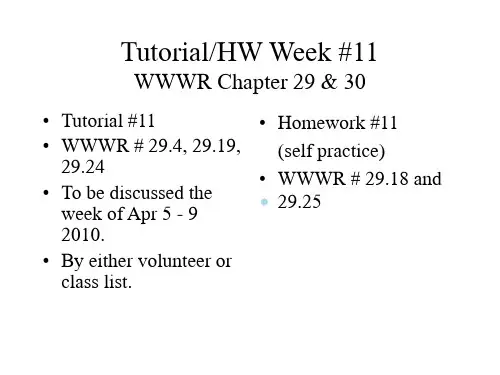
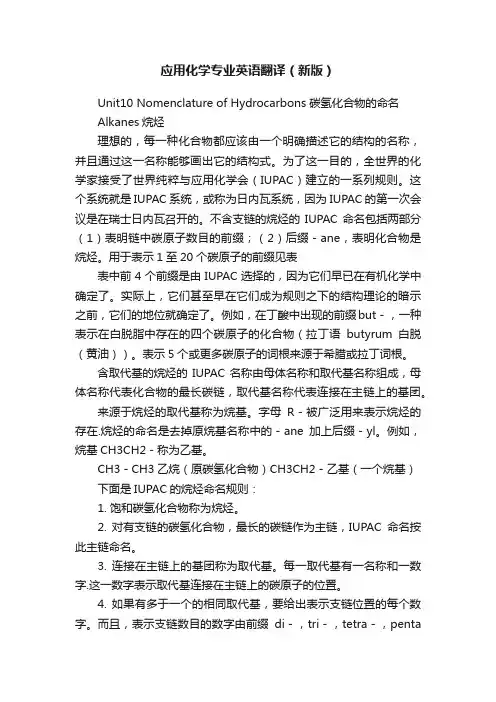
应用化学专业英语翻译(新版)Unit10 Nomenclature of Hydrocarbons碳氢化合物的命名Alkanes烷烃理想的,每一种化合物都应该由一个明确描述它的结构的名称,并且通过这一名称能够画出它的结构式。
为了这一目的,全世界的化学家接受了世界纯粹与应用化学会(IUPAC)建立的一系列规则。
这个系统就是IUPAC系统,或称为日内瓦系统,因为IUPAC的第一次会议是在瑞士日内瓦召开的。
不含支链的烷烃的IUPAC命名包括两部分(1)表明链中碳原子数目的前缀;(2)后缀-ane,表明化合物是烷烃。
用于表示1至20个碳原子的前缀见表表中前4个前缀是由IUPAC选择的,因为它们早已在有机化学中确定了。
实际上,它们甚至早在它们成为规则之下的结构理论的暗示之前,它们的地位就确定了。
例如,在丁酸中出现的前缀but-,一种表示在白脱脂中存在的四个碳原子的化合物(拉丁语butyrum白脱(黄油))。
表示5个或更多碳原子的词根来源于希腊或拉丁词根。
含取代基的烷烃的IUPAC名称由母体名称和取代基名称组成,母体名称代表化合物的最长碳链,取代基名称代表连接在主链上的基团。
来源于烷烃的取代基称为烷基。
字母R-被广泛用来表示烷烃的存在.烷烃的命名是去掉原烷基名称中的-ane加上后缀-yl。
例如,烷基CH3CH2-称为乙基。
CH3-CH3乙烷(原碳氢化合物)CH3CH2-乙基(一个烷基)下面是IUPAC的烷烃命名规则:1. 饱和碳氢化合物称为烷烃。
2. 对有支链的碳氢化合物,最长的碳链作为主链,IUPAC命名按此主链命名。
3. 连接在主链上的基团称为取代基。
每一取代基有一名称和一数字.这一数字表示取代基连接在主链上的碳原子的位置。
4. 如果有多于一个的相同取代基,要给出表示支链位置的每个数字。
而且,表示支链数目的数字由前缀di-,tri-,tetra-,penta-等表示。
5. 如果有一个取代基,主链碳原子编号从靠近支链的一端开始,使支链位号最小。
应用化学专业英语朱红军第二版课文翻译Unit 7 Physical ChemistryPhysical chemistry is the study of the physical basis of chemical systems and processes. Modern physical chemistry is firmly grounded upon physica. Important areas of study include chemical thermodynamics, chemical kinetics, quantum chemistry, statistical mechanics, electrochemistry, surface and solid state chemistry, and spectroscopy.物理化学是对化学系统和过程的物理基础的研究。
现代物理化学以物理为基础。
重要的研究领域包括化学热力学、化学动力学、量子化学、统计力学、电化学、表面和固体化学以及光谱学。
We have repeatedly referred to the energy effects accompanying chemical and physical changes. Thermodynamics is the study of these energy effects in particular, it summarizes the relations between heat, work, and other forms of energy that are involved in all types of changes. The laws of thermodynamics can be used to predict whether a particular chemical or physical transformation is theoretically possible under a given set of conditions. Furthermore, if a study shows that a desired change will not occur under the conditions assumed, thermodynamic principles can be used to determine how the conditions can be altered to make the change theoretically possible.我们一再提到伴随着化学和物理变化的能量效应。
Aabscissa[æbˈsɪsə] n. 横座标 abundance n. 丰富, 充裕acceptor n. 接受体accumulator n. 储料器 acetic acid n. 醋酸, 乙酸 acknowledge v. &n. 致谢activation n. 活化acylation ['æsil] n. 酰化addition [əˈdiʃən] n. 加成反应adhesive [ædˈhisɪv, -zɪv] n. 粘合剂advancement n. 进展,增长advantageous adj. 有利的aerosol[ˈeərəˌsɔ:l, -ˌsɔl] n. 烟雾affinity [əˈfɪnɪti:] n. 亲合力agent [ˈeidʒənt] n. 试剂aldehyde [ˈældəˌhaɪd]n. 醛aldol[ˈældəul]n. 醛醇aliphatic acid [ˌæliˈfætik]n. 脂肪酸alkaline[ˈælkəlɪn, -ˌlaɪn] adj. 碱的alkaloid[ˈæl kəlɔid] n. 生物碱alkane[ˈælˌken]n. 烷烃alkene[ˈælki:n]n. 烯烃alkylation [ˌælkiˈleiʃ(ə)n]n. 烃化, 烷基化alkyl halide[ˈælkil][ˈhælaid]n. 烷基卤, 卤烷alkyne n. 炔alphabetic adj. 依字母顺序ambiguity n. 模糊, 意义不明确amide n. 酰胺amine n. 胺amino acid n. 氨基酸amorphous adj. 无定形analogue n. 类似物anhydride n. 酸酐aniline n. 苯胺anion n. 阴离子anomaly n. 异常,反常antibiotics n. 抗菌素antifreezing agent n. 抗冻剂antioxidant n. 抗氧剂appreciable adj. 可估计的architect n. 建筑师, 设计师arene n. 芳烃aromatic adj. 芳香的aromatization n. 芳构化asymmetric adj. 不对称的autooxidation n. 自氧化awarenness n, 意识azeotrope n.共沸混合物azo dye n. 偶氮染料Bbackup n. /adj 备用设备base n. 碱, 基, 底beaker n. 烧杯benzene n. 苯biological degradation n. 生物降解biosynthesis vt. 生物合成bleach vt. 漂白bond n. 键branched chain n. 支链budget n. & v. 预算bubble-cap tower n. 泡罩塔buffer n. 缓冲,缓冲剂Ccarbanion n. 负碳离子, 阴碳离子carbene n. 碳烯, 卡宾carbide n. 碳化物, 碳化钙carbocation n. 正碳离子, 阳碳离子carbonyl group n. 羰基carboxy group n. 羧基carboxylic acid n. 羧酸carcinogenic adj. 致癌的β-carotene n. β胡萝卜素carrier n. 载体cartridge n. 软片暗盒catalysis n. 催化(作用) cation n. 阳离子cellulose n. 纤维素ceramic adj/n. 陶瓷(的) chemical shift n. 化学位移chirality n. 手性chlorination n. 氯化作用chlorohydrocarbon n. 氯代烃chromophore n. 发色团cis-trans isomer n. 顺反异构体classic adj. 经典的, 传统的cluster n. 蔟,一串,一束coherent adj. 黏附的,相干的(光学) coil n. 蛇管colorant n. 颜料,着色剂commodity n. 用品compensation n. 补偿competitive n. 竞争的complementary n. 补充的complex n. 络合物complication n. 复杂concerted reaction n. 协同反应condensation n. 缩合反应condiment n. 调味品conformation n. 构象conjugation n. 共轭construction n. 建设, 建筑consultant n. 顾问consumer n. 消耗container n. 容器containment n. 抑制cooler n. 冷却器corporate adj. 共同的correlate n. 相关的事物cosmetic n. 化妆品counteract vt. 抵消,抵抗coupling reaction n. 偶合反应covalent bond n. 共价键critical adj. 临界的cumulative adj. 累积的,累加的customary adj. 通常的, 常例的cycloparaffin n. 环烷烃Ddecolorant n. 脱色剂decolorize v. 脱色degradation n.降解dehydration n. 脱水作用dehydrogenation n. 脱氢作用delocalization n. 离域作用denatured alcohol n. 变性酒精denominator n. 分母derivation n. 衍生,由来derivative n. 衍生物desorption n. 解吸作用destructive distillation 分解蒸馏detergent n. 洗涤剂developer n. 显影剂dextrorotary adj. 右旋的diazonium salt n. 重氮盐diazotization n. 重氮化作用dielectric adj.不导电的,n.电介质dipole n. 偶极directory n. 地址录disclose vt. 揭露, 揭发discrete adj. 离散的,不连续的disposal vt. 排出, 处理director n. 定位基dissolve v.溶解distillation n. 蒸馏dominant adj. 支配的,统治的donor n. 给体drastic n. 激烈的, 猛烈的droplet n. 液滴dyestuff n. 染料Eelectrophilic reagent n. 亲电试剂electrophobic adj 疏电子的electronegative adj 电负性的electron withdrawing group n. 吸电子基electrostatic adj. 静电的elimination n. 消除反应emulsion n. 乳剂endothermic adj. 吸热的enantiomer n. 对映体enzyme n. 酶epoxy adj. 环氧化的essential oil n. (香)精油ester n. 酯esterification n. 酯化作用ethanol n. 乙醇ether n. 醚, 乙醚ethyl n. 乙基ethylene n. 乙烯ethynyl n. 乙炔基evaluation n. 评价,估价evaporation n. 蒸发excitation n. 激发态exothermic adj. 放热的extract vt. 萃取extrapolation n. 推断Ffermentation n. 发酵fiber n. 纤维filament n. 细丝,丝状体filter n.过滤器,滤色片flare v. & n. 闪耀, 闪烁flavoring n. 香剂, 调味剂fluorescent n. 荧光fore adj. 先时的, 前部的formaldehyde n. 甲醛fossil n. 化石fractional distillation n. 分馏free radical n. 自由基fumigant n. 熏蒸(消毒)剂functional group n. 官能团furan n. 呋喃Ggeneralization n. 一般(性), 普遍(性) genetic code n. 遗传密码geological adj. 地质(学)的geomatrical adj. 几何学的glacial acetic acid n. 冰醋酸glucose n. 葡萄糖glycerol n. 甘油, 丙三醇graphics n. 图,制图法Hhabituation n. 习惯作用, 毒瘾halogenation n. 卤化hazardous adj. 危险的, 有危害的herbicide n.除草剂heterocyclic compound n.杂环化合物heterogeneous adj. 非均相的, 多相的hexagon n. 六边形highlight n. 光线明亮处hold-up n. 塔储量, 容纳量homologous series n. 同系列hormone n. 激素humectant n. 润湿剂hybrid n. 杂化hydration n. 水合作用hydrogenation n. 氢化作用hydrolysis n. 水解hydrophobic adj. 疏水的hydroxyl group n. 羟基Iidealize vt. 理想化inasmuch as adv. 因为, 由于indicator n. 指示剂indiscriminate adj. 不加选择的indol n. 吲哚inductive effect n. 诱导效应ineffective adj. 无效的, 低效率的infrared spectroscopy n. 红外光谱ingenious adj. 坦率的, 天真的ingestion n. 吸收, 吸入inlet n. 进口, 入口insecticide n. 杀虫剂insulin n. 胰岛素integrate vt. 积分,使...一体化interchangeable adj. 可互换的intermediate n. 中间体ion n. 离子isoelectric point n. 等电点isomer n. 异构体Jjacket n. 套, 夹套justification n. 认为正当, 正当的理由Kketone n. 酮Llactic acid n. 乳酸leakage n. 泄漏lesser adj. 较小的, 更少的lime n. 石灰lining n. 衬里, 衬料, 衬套link vt. 连接,键合liquefy vt. 液化lubricating grease n. 润滑脂Mmanipulation n. 操作, 操纵manuscript n. 稿子, 手稿mass spectroscopy n. 质谱mechanism n. 机理, 历程medium n. 介质, 培养基metallurgical adj. 冶金(学)的methane n. 甲烷methnol n. 甲醇methodology n. 方法论micelle n. 胶粒microorganism n. 微生物migrate vi. 迁移miscible adj. 可溶混的modification n. 修饰monomer n. 单体monosaccharide n. 单糖multiplet n. 多重峰multiplicity n 多重性Nnaphthalene n. 萘nitration n. 硝化作用nitric acid n. 硝酸nitrile n. 腈noble adj. 贵重的, 惰性的nomenclacture n. 命名法noteworthy adj. 显著的nucleophile n. 亲核试剂nucleic acid n. 核酸neutralization n. 中和numerator n. (数学上) 分子nutrient n. 营养素, 养分Oobservable a. 可观察到的octane number n. 辛烷值olefin n. 烯烃optical activity n. 旋光性optics n. 光学optimum n. 最佳条件orbital n. 轨道organometallic compound 金属有机化合物originate vi./vt. 起源outermost adj. 最外层的,远离中心的overhead n. 塔顶馏出物overheat vt. 过热overlap vt. 重叠oxidation n. 氧化作用ozonide n. 臭氧化合物ozonolysis n. 臭氧分解Pparaffin n. 链烷烃, 石蜡peptide n. 肽perfume n. 香料peroxide n. 过氧化合物persistence n. 坚持, 固执pesticide n. 杀虫剂pharmaceuticals n. 药物phenol n. 苯酚phenoxide n. (苯)酚盐phenylsulfonic acid n. 苯磺酸phosphoric acid n. 磷酸photochemical reaction n. 光化学反应photochromism n. 光致变色photoconductivity n. 光电导性pigment n. 颜料pink n. 粉红色polyamide n. 聚酰胺polarization n. 极化作用polyhydric alcohol n. 多元醇polymerization n. 聚合作用precipitate vi. /n. 沉淀preservative n. 防腐剂prolong vt. 延长, 拖延propellant n. 推进剂prospective adj. 预期的, 有希望的protecting group n. 保护基purity n. 纯度pyridine n. 吡啶pyrolysis n. 热解pyrrole n. 吡咯Qquantify vt. 使量化,确定数量quaternary ammonium salt n. 季铵盐quench vt. 淬灭quinoline n. 喹啉Rracemization n. 外消旋作用reagent n. 试剂realization n. 实现recover vt. 回收recrystallization n. 重结晶rectifier n. 精馏器reduction n. 还原(作用) reflux n. 回流refract vt. 折射refrigerant n. 冷冻剂remainder n. 剩余物, 残余部分的replica n. 复制品,拷贝resolution n. 分辨, 拆开restrictive adj. 限制性的ribonucleic acid n. 核糖核酸(RNA) rigorous adj. 严厉(格)的Ssaccharin n. 糖精saponification n. 皂化(作用) screen n. 筛子, 屏幕seal n. 密封(垫) segment n. 部分, 链段selectivity n. 选择性settle vt. (使)沉淀, 澄清setup vt. 装置, 装配sewage n. 污水silica gel n. 硅胶singlet n. 单重峰skeleton n. 骨架solubility n. 溶解度solvant n. 溶剂化物solvent n. 溶剂, 有溶解力的sophistication n. 复杂spectroscopy n. 光谱spin-spin coupling n. 自旋-自旋偶合stabilization n. 稳定作用stereoisomerism n. 立体异构现象steric factors n. 位阻因素, 空间因素still pot n.蒸馏釜stoichiometric adj. 化学计算的straightforward adj.一直向前, 正直的substituent n. 取代基substitution reaction n. 取代反应sucrose n. 蔗糖sulfa drug n. 磺胺药sulfonation n.磺化作用sulfuric acid n. 硫酸supervisor n. 导师, 监督人, 主管人suspension n. 悬浮液sweetener n. 增甜剂symmetry n. 对称性symposium n. 座谈会syn addition n. 顺式加成Ttar n. 焦油(沥青)tartaric acid n. 酒石酸tautomerism n. 互变异构现象terpene n. 萜烯tertiary adj. 叔的, 第三的tetrahedron n. 四面体thiazole n. 噻唑thiophene n. 噻吩toluene n. 甲苯toxicity n. 毒性transesterification n. 酯交换反应transition state n. 过渡状态tray n. 盘, 分馏塔盘triplet n. 三重峰trivial adj. 轻微的Uultraviolet-visible spectroscopy n. 紫外-可见光谱unify vt. 统一urea n. 尿素Vvalidate vt. 使生效vaporize vt.蒸发versatile adj. 多方面的vice versa adj. 反之也然vinegar n. 醋violate vt. 破坏,侵害Wwhereas conj. 而, 却, 鉴于withdraw vt. 拉, 提取, 取出withdrawal n. 收回,撤回Xxerography n. 静电复印法Yyeast n. 酵母Zzymochemistry n. 酶化学。
1、化学的起源化学可以被广泛的定义为分子的科学和它们之间的转换。
和数学不同,化学在人类之前。
我们的星球(地球)上的生命和人类的外观很可能是化学进程的具体结果。
化学过程从历史的开端一直到现在都出现在人们的生活中。
最初,这些过程不在我们的掌控之中,例如,果汁的发酵,肉和鱼的腐烂,木头的燃烧。
后来我们学着去控制化学进程使用它来生产不同的产品,比如食物,金属,陶瓷和皮革。
在化学的发展上,主要区分为四个阶段:史前化学,希腊化学,炼金术,科学化学。
早期的化学很明显是被人们实际需要所激发的。
火的发现提供了史前人类开始控制化学反应的一次机会。
他们合成一些黄铜,青铜和其他易得材料的物品。
因为人类早期对化学过程的应用早于记载,所以没有关于它们化学技能的记录。
唯一可以判断它们化学能力的是考古的发现和不同的人造品。
正如早期数学发展一样,实际需要影响着化学的发展。
但是化学和数学在这个阶段很可能没有关系。
即使有,也没有记录来确定这些。
希腊化学主要建立在推测的基础上而不是在实验的基础上。
这是古希腊所有科学的普遍特征。
古希腊科学家实际上是哲学家,所以希腊对思考如此感兴趣盛于实验也就不足为奇了。
事实上他们很少做思考之外的实验。
这对数学是一个好的方法但是却不是对于物理,化学和生物科学。
然而,希腊人思考了许多关于自然和物质结构,他们可以被看作早期化学理论的创造者。
希腊引进了元素的概念总共提出了四种元素。
Thalesren 认为所有的东西来自一种基本的物质,就是水。
Anaximenes,接受了元素的概念,但他认为来单独的元素自于空气中的物质。
Heraclitus,认为宇宙的基本的特点是不断变化的,把火作为永久变化的元素。
Empedocles摒弃了了单独元素的概念并引进了四种元素:水,空气,火和土,他也因为他的实验证明了空气是一种物质结构而出名。
火这种元素最早被柏拉图引用他猜测每种元素的粒子有特定的形体,尽管这种粒子太小以至于看不见。
因此,火的最小的粒子有规则的四面体结构,空气是八面体,水是二十面体,土是立方体(主要是六面体)。
1. Applied Chemistry 应用化学2. Reaction Mechanisms 反应机理3. Homogeneous Catalysis 均相催化剂4. Heterogeneous Catalysis 非均相催化剂5. The pH Scales pH值6. Proton-Transfer Reactions 质子转移反应7. Conjugate Acid-Base Pairs 共轭酸碱对8. Relative Strength of Acids and Bases 酸碱的相对强度9. Lewis Acids and Bases 路易斯酸碱10. Hydrolysis of Metal Ions 金属离子的水解11. Buffer Solutions 缓冲溶液12. The Common-Ion Effects 同离子效应13. Buffer Capacity 缓冲容量14. Formation of Complex Ions 配离子的形成15. Solubility 溶解度16. The Solubility-Product Constant K sp溶度积常数17. Precipitation and separation of Ions 离子的沉淀与分离18. Selective Precipitation of Ions 离子的选择沉淀19. Oxidation-Reduction Reactions 氧化还原反应20. Half-Reaction 半反应21. Galvani Cell 原电池22. V oltaic Cell 伏特电池23. Cell EMF 电池电动势24. Energies of Orbital 轨道能量25. The Pauli Exclusion Principle 泡林不相容原理26. Electron Configurations 电子构型27. The Periodic Table 周期表28. Friedel-Crafts reaction 傅列德尔-克拉夫茨反应29. carboxylic acid derivative 羧酸衍生物30.Isotopes, Atomic Numbers, and Mass Numbers 同位素,原子数,质量数31. Periodic Properties of the Elements 元素的周期律32. Radius of Atoms 原子半径33. Ionization Energy 电离能34. Electronegativity 电负性35. Effective Nuclear Charge 有效核电荷36. Electron Affinities 亲电性37. Valence Bond Theory 价键理论38. Covalence Bond 共价键39. Orbital Overlap 轨道重叠40. Hybrid Orbital 杂化轨道41. The VSEPR Model 价层电子对互斥理论42. Molecular Geometries 分子空间构型43. Molecular Orbital 分子轨道44. Diatomic Molecules 双原子分子45. Bond Length 键长46. Bond Order 键级47. Bond Angles 键角48. Bond Enthalpies 键能49. Bond Polarity 键矩50. Dipole Moments 偶极矩51. Polarity Molecules 极性分子52. Polyatomic Molecules 多原子分子53. Crystal Structure 晶体结构54. Non-Crystal 非晶体55. Close Packing of Spheres 球密堆积56. Metallic Solids 金属晶体57. Metallic Bond 金属键58. Kekule structure 凯库勒结构式59. Ionic Solids 离子晶体60. Ion-Dipole Forces 离子偶极力61. Molecular Forces 分子间力62. Intermolecular Forces 分子间作用力63. Hydrogen Bonding 氢键64. Covalent-Network Solids 原子晶体65. Compounds 化合物66. The Nomenclature, Composition and Structure of Complexes 配合物的命名,组成和结构67. Charges, Coordination Numbers, and Geometries 电荷数、配位数、及几何构型68. Isomerism 异构现象69. Structural Isomerism 结构异构70. Stereoisomerism 立体异构71.Electron Configurations in Octahedral Complexes 八面体构型配合物的电子分布72. Tetrahedral and Square-planar Complexes 四面体和平面四边形配合物73. General Characteristics 共性74. s-Block Elements s区元素75. Alkali Metals 碱金属76. Alkaline Earth Metals 碱土金属77. Peroxides and Superoxides 过氧化物和超氧化物78. Hydroxides 氢氧化物79. p-Block Elements p区元素80.Boron Group (Boron, Aluminium, Gallium, Indium, Thallium) 硼族(硼,铝,镓,铟,铊)81. Carbon Group (Carbon, Silicon, Germanium, Tin, Lead) 碳族(碳,硅,锗,锡,铅)82. Carbonic Acid, Carbonates and Carbides 碳酸,碳酸盐,碳化物83. Nitrogen Group (Phosphorus, Arsenic, Antimony, and Bismuth) 氮族(磷,砷,锑,铋)84. Oxygen Group (Oxygen, Sulfur, Selenium, and Tellurium) 氧族元素(氧,硫,硒,碲)85. Sulfides 硫化物86. Halogens (Fluorine, Chlorine, Bromine, Iodine) 卤素(氟,氯,溴,碘)87. Halides, Chloride 卤化物,氯化物88. The Noble Gases 稀有气体89. Noble-Gas Compounds 稀有气体化合物90. Transition Metals 过渡金属91. f-Block Elements f区元素92. analytical chemistry 分析化学93. qualitative analysis 定性分析94. quantitative analysis 定量分析95. chemical analysis 化学分析96. instrumental analysis 仪器分析97. titrimetry 滴定分析98. gravimetric analysis 重量分析法99. regent 试剂100. chromatographic analysis 色谱分析101. electrochemical analysis 电化学分析102. on-line analysis 在线分析103. macro analysis 常量分析104. characteristic 表征105. micro analysis 微量分析106. deformation analysis 形态分析107. semimicro analysis 半微量分析108. systematical error 系统误差109. routine analysis 常规分析110. random error 偶然误差111. gross error 过失误差112. normal distribution 正态分布113. deviation偏差114. precision精密度115. relative standard deviation相对标准偏差(RSD)116. coefficient variation变异系数(CV)117.confidence level置信水平118. confidence interval置信区间119. significant test显著性检验120. significant figure有效数字121. standard solution标准溶液122. titration滴定123. stoichiometric point化学计量点124. titration error滴定误差125. primary standard基准物质126. amount of substance 物质的量127. chemical equilibrium化学平衡128. general equation for a chemical reaction化学反应的通式129. proton theory of acid-base酸碱质子理论130. acid-base titration 酸碱滴定法131. dissociation constant解离常数132. conjugate acid-base pair 共轭酸碱对133. hydronium ion水合氢离子134. electrolyte 电解质135. ion-product constant of water水的离子积136. ionization电离137. proton condition质子平衡138. buffer solution缓冲溶液139. acid-base indicator 酸碱指示剂140. coordination compound配位化合物141. center ion中心离子142. cumulative stability constant累积稳定常数143. alpha coefficient酸效应系数144. overall stability constant 总稳定常数145. ligand 配位体146. side reaction coefficient副反应系数147. coordination atom配位原子148. coordination number 配位数149. lone pair electron孤对电子150. metal indicator 金属指示剂151. masking掩蔽152. demasking解蔽153. oxidation氧化154. catalyst催化剂155. reduction还原156. electrode potential电极电势157. redox couple 氧化还原电对158. redox indicator氧化还原指示159. oxygen consuming耗氧量(OC)160. chemical oxygen demanded 化学需氧量(COD) 161. dissolved oxygen 溶解氧(DO)162. precipitation 沉淀反应163. argentimetry银量法164. heterogeneous equilibrium of ions 多相离子平衡165. spectrophotometry分光光度法166. transmittance透光率167. absorptivity吸光率168. absorption cell吸收池169. bathochromic shift红移170. Molar absorptivity摩尔吸光系数171. bimolecular elimination 双分子消除反应173. bimolecular nucleophilic substitution 双分子亲核取代反应174. open chain compound 开链族化合物175. molecular orbital theory 分子轨道理论176. chiral molecule 手性分子177. tautomerism 互变异构现象178. chemical shift 化学位移179. Enantiomorph 对映体180. addition reaction 加成反应181. dextro- 右旋182. levo- 左旋183. stereochemistry 立体化学184. stereoisomer 立体异构体185. Lucas reagent 卢卡斯试剂186. covalent bond 共价键187. conjugated double bond 共轭双键188. hybrid orbital 杂化轨道189. heterocyclic compound 杂环化合物190. peroxide effect 过氧化物效应191. valence bond theory 价键理论192. electron-attracting grou p 吸电子基193. Huckel rule 休克尔规则194. Hinsberg test 兴斯堡试验195. infrared spectrum 红外光谱196. Michael reacton 麦克尔反应197. halogenated hydrocarbon 卤代烃198. Polymer 聚合物199. systematic nomenclatur 系统命名法200. Newman projection 纽曼投影式201. aromatic compound 芳香族化合物202. aromatic character 芳香性203. Claisen condensation reaction 克莱森酯缩合反应204. Claisen rearrangement 克莱森重排205. Diels-Alder reation 狄尔斯-阿尔得反应206. Clemmensen reduction 克莱门森还原207. Cannizzaro reaction 坎尼扎罗反应208. positional isomers 位置异构体209. unimolecular elimination reaction 单分子消除反应210. unimolecular nucleophilic substitution 单分子亲核取代反应211. The Nernst Equation 能斯特方程212. conformation 构象213. confomational isome 构象异构体214. nucleophilic substitution reaction 亲核取代反应215. active intermediate 活性中间体216. Saytzeff rule 查依采夫规则217. cis-trans isomerism 顺反异构218. inductive effect 诱导效应219. Fehling’s reagent 费林试剂220. phase transfer catalysis 相转移催化作用221. aliphatic compound 脂肪族化合物222. elimination reaction 消除反应223. nuclear magnetic resonance 核磁共振224. allyl cation 烯丙基正离子225. leaving group 离去基团226. optical activity 旋光性227. boat confomation 船型构象228. silver mirror reaction 银镜反应。
化学专业课程中英文对照普通化学General Chemistry分析化学Analytical Chemistry有机化学Organic Chemistry物理化学Physical Chemistry谱学导论Introducton of Spectroscopy无机化学Inorganic Chemistry普通化学和分析化学实验Experiments of General and Analytical Chemistry 现在基础化学The Principle of Mordern Chemistry现在基础化学实验Experiments of Modern Fundamental Chemistry有机化学实验Experiments of Organic Chemistry仪器分析和物理化学实验Experiments of Instrumental Analysis and Physical Chemistry合成化学实验Experiments of Synthetic Chemistry现代化学专题Topic of Modern Chemistry化学综合实验Experiments of Comprehensive Chemistry化工原理Principle of Chemical Engineering化工原理实验Experiments of Chemical Engineering应用化学实验Experiments of Applied Chemistry无机合成化学Synthetic Inorganic Chemistry近代分析化学Modern Analytical Chemistry A分离分析化学Separation Analytical Chemistry有机化合物波谱鉴定Spectrum Identification of Organic Compounds有机合成及反应机理Organic Synthesis and Mechanics化学进展Progress in Chemistry化学反应工程Chemical Reaction Engineering应用电化学Applied Electrochemistry工业催化Industrial Catalysis环境化学Environmental Chemistry环境监测Environmental Monitoring化学科技英语Scientific English for Chemistry数理方法在化学中的应用Mathematical Statistics for Chemistry化工制图Chemical Engineering Cartography计算机与化学测量实验Computer and Chemical Measurement化学信息学Chemoinformatics or Chemical Informatics应用化学专题Special Topics in Applied Chemistry化工装置常用词汇1一概论introduction方案(建议书) proposal可行性研究feasibility study方案设计concept design工艺设计process design基础设计basic design详细设计detail design开工会议kick-off meeting审核会议review meeting夕卜商投资foreign investment中外合资joint venture中外合营joint venture补偿贸易compensation trade合同合同附件contract卖方vendor买方buyer顾客client承包商contractor工程公司company供应范围scope of supply生产范围production scope生产能力production capacity项目project界区battery limit装置plant公用工程utilities工艺流程图process flow diagram工艺流程方块图process block diagram管道及仪表流程图piping and instrument drawing物料及热量平衡图mass & heat balance diagram蒸汽及冷凝水平衡图steam & condensate balance diagram 设备布置图equipment layout设备表equipment list成品(产品) product(final product)副产品by-product原料raw-material设计基础数据basic data for design技术数据technical data数据表data sheet设计文件design document设计规定design regulation现场服务site service项目变更project change用户变更client change消耗定额consumption quota技术转让technical transfer技术知识technical know-howtechnical knowledge技术保证technical guaranteeconsultative services technical services location construction field quotation bidding book company profit fixed price contract fixed unit price contract cost plus award fee contract mobilizationbank guarantee letter retention income taxes special contractor's taxes city and municipal taxes work manualwork flow diagramQA/QC procedures procurement plan construction plan construction schedule project execution plan project coordination procedure project master schedule engineering network logic project quality assurance project quality control procurementprocurement period the squad check calculation sheets inquiry inspection transportation start up / commission inspection & acceptance check review approve version department specialtyproject number咨询服务技术服务工作地点施工现场报价 标书 公司利润固定价合同 固定单价合同 成本加酬金合同 定金银行保证书保留金 所得税 特别承包人税城市和市政税 工作手册 工作流程图 质量保证程序 采购计划 施工计划 施工进度 项目实施计划 项目协调程序 项目总进度计划 设计网络计划 项目质量保证 项目质量控制 采购采购周期 会签计算书 询价 检验 运输 开车验收 校核 审核审定 版次 部门专业 项目号图号drawing number目录contents序言foreword章chapter节section项itemMR material requisitionSPEC engineering specificationDATA SHEET (技术表)technical data sheetTBA(技术评标)technical bid analysis TBA(技术评标)PDP preliminary design packagePM (项目经理)project managerLDE(专业负责人)lead discipline engineerMRQ(材料询价单)Material requisition for quotation MRP (材料米购单)material requisition for purchaseBEP (基础工程设计包)basic engineering packageP&ID (管道及仪表流程图)piping and instrument drawing(diagram)PFD process flow diagramNNF normally no flowFO failure openFC failure closeC/S/A civil/structure/architectureDDP (详细设计阶段)detail design phase二. 工艺流程连续过程continuous process间歇过程batch process工艺叙述process description工艺特点process feature操作operation反应reaction 副反应side reaction 絮凝flocculation浮洗flotation倾析decantation催化反应catalytical reaction 萃取extraction中和neutralization水解hydrolysis过滤filtration干燥drying还原reduction氧化oxidation氢化hydrogenation分解decomposition离解dissociation合成synthetics吸收absorption吸附adsorption解吸desorption结晶crystallization溶解solution调节modulate控制control悬浮suspension循环circulation再生regeneration再活化reactivation沥取leaching破碎crushing煅烧caloination沉降sedimentation沉淀precipitation气化gasification冷冻refrigeration固化、结晶solidification包装package升华sublimation燃烧combustion引烧ignition蒸馏distillation碳化carbonization压缩compression三、化学物质及特性固体solid液体liquid气体gas 化合物compound 混合物mixture 粉powder片状粉未flake 小粒granule结晶crystal乳化物emulsion氧化物oxidizing agent还原剂reducing agent有机物organic material真空vacuum母液master liquor富液rich liquor贫液lean liquor萃出物extract萃余物raffinate絮凝剂flocculants冷冻盐水brine 酸度acidity浓度concentration碱度alkalinity溶解度solubility凝固点solidificalion point沸点boiling point熔点melting point蒸发率evaporation rate粘度viscosity吸水的water absorbent(a) 无水的anhydrous(a)夕卜观appearance无色的colorless(a)透明的transparent(a)半透明的translucent 密度density比重specific gravity 催化剂catalyst燃烧combustion引燃ignition自然点self-ignition temperature可燃气体combustible gas可燃液体inflammable liquid易燃液体volatile liquid爆炸混合物explosive mixture爆炸性环境explosive atmosphere(environment) 爆炸极限explosive concentration limit废水waste water废液waste liquid废气off-gas噪声noise pollution成分composition挠度deflection力和力矩force and moment弯矩bending moment应力-应变曲线stress-strain diagram百分比percentage环境温度ambient temperature工作温度operating设计温度design temperature(pressure)相对湿度RH=relative humidity油渣、淤泥sludge 杂质impurity四、化工设备泵pump 轴流泵axial flow pump 真空泵vacuum pump屏蔽泵canned pump柱塞泵plunger pump涡轮泵turbine pump涡流泵vortex pump离心泵centrifugal pump喷射泵jet pump转子泵rotary pump管道泵inline pump双作用往复泵double action reciprocating pump计量泵metering pump深井泵deep well pump齿轮泵gear pump手摇泵hand(wobble) pump螺杆泵screw (spiral) pump潜水泵submersible pump斜转子泵inclined rotor pump 封闭式电磁泵hermetically sealed magnetic drive pump 气升泵air-lift-pump轴承bearing叶轮impeller虹吸管siphon高压容器high pressure vessel 焚化炉incinerator火焰清除器flame arrester 工业炉furnace烧嘴burner锅炉boiler回转窑rotary kiln加热器heater电加热器electric heater冷却器cooler冷凝器condenser换热器heat exchanger反应器reactor蒸馏釜still搅拌器agitator混合器mixer静态混合器static mixers管道混合器line mixers混合槽mixing tanks破碎机crusher磨碎机grinder研磨机pulverizer球磨机ballmill过滤器filter分离器separator干燥器drier翅片fins烟囱stack火炬flare筛子screen煅烧窑calciner倾析器decanter蒸发器evaporator再沸器reboiler萃取器extractor离心机centrifuger吸附(收)器adsorber 结晶器crystallizer电解槽electrolyzer电除尘器electric precipitator 洗涤器scrubber 消石灰器slaker 料仓bin 料斗hopper加料器feeder增稠器thickener澄清器clarifier分级器classifier浮洗器flocculator废液池sump喷射器ejector喷头sprayer成套设备package unit仪器设备apparatus附属设备accessory旋转式压缩机rotary compressor往复式压缩机reciprocating compressor水环式压缩机nash compressor螺杆式压缩机helical screw compressor离心式压缩机centrifugal compressor多级压缩机mutiple stages compressor固定床反应器fixed bed reactor流化床反应器fluidized bed reactor管式反应器tubular reactor列管式换热器tubular heat exchanger螺旋板式换热器spiral plate heat exchanger 萃取塔extraction column板式塔plate column填料塔packed column洗涤塔scrubber吸收塔absorber冷却塔cooling tower精馏塔fractionating tower汽提塔stripper再生塔regenerator造粒塔prill tower塔附件tower accessories液体分配(布)器liquid distributor填料支持板support plate定距管spacer降液管downcomer升气管chimney顶(底)层塔盘top (bottom) tray挡板baffle抽出口draw nozzle溢流堰weir泡罩bubble cap筛板sieve plate浮阀float valve除沫器demister pad塔裙座skirt椭圆封头elliptical head高位槽head tank中间槽intermediate tank加料槽feed tank补给槽make-up tank计量槽measuring tank电解槽cell溜槽chute收集槽collecting tank液滴分离器knockout drum稀释罐thinning tank 缓冲罐surge drum回流罐reflux drum闪蒸罐flash drum浮顶罐floating roof tank内浮顶罐covered floating roof tank 球罐spheroid 气柜gas holder 湿式气柜wet gas-holder 干式气柜dry gas-holder 螺旋式气柜helical gas-holder星型放料器,旋转阀rotary valve抽滤器mutche filter压滤器filter press压滤机pressure filter板框压滤器plate-and-fram filter press转鼓过滤器rotary drum filter带式过滤器belt filter翻盘式过滤器袋滤器bag filter 旋风分离器cyclone separator盘式干燥箱compartment tray drier真空干燥器vacuum drier隧道式干燥器tunnel drier回转干燥器rotary drier穿流循环干燥器through circulation drier 喷雾干燥器spray drier 气流干燥器pneumatic conveyor drier圆盘式加料器dish feeder螺旋式加料器screw feeder颚式破碎机jaw crusher回转破碎机gyratory crusher滚洞破碎机roll crusher锤式破碎机hammer crusher冲击破碎机rotor impact breaker气流喷射粉碎机jet pulverizer 棍磨机rod mill雷蒙机raymond mill锤磨机hammer mill辊磨机roller mill振动筛vibrating screen回转筛rotary screen风机fan罗茨鼓风机root's blower起重机crane桥式起重机bridge crane电动葫芦motor hoist发电机generator电动机motor汽轮机steam turbine五、管道工程piping engineering1阀门valve阀杆stem内螺纹阀杆inside screw阀座valve seat (body seat)阀座环、密封圈sealing ring阀芯(包括密封圈,杆等)trim阀盘disc阀体body阀盖bonnet手轮hand wheel手柄hand level (handle)压盖gland闸阀gate valve平行双闸板double disc parallel seat楔形单闸板split wedge截止阀globe valve节流阀throttle valve针阀needle valve角阀(角式截止阀)angle valveY 型阀(截止阀)Y-valve(Y-body globe valve)球阀ball valve三通球阀3-way ball valve蝶阀butterfly valve对夹式(薄片型)wafer type偏心阀板蝶阀offset disc (eccentric) butterfly valve 斜阀盘蝶阀canted disc butterfly valve连杆式蝶阀link butterfly valve止回式蝶阀combined non-return butterfly valve柱塞阀piston type valve旋塞阀plug valve三通旋塞阀three-way plug valve四通旋塞阀four-way plug valve旋塞cock衬套旋塞sleeve cock隔膜阀diaphragm valve橡胶衬里隔膜阀rubber lined diaphragm valve直通式隔膜阀straight way diaphragm valve夹紧式胶管阀pinch valve止回阀check valve升降式止回阀lift check valve旋启式止回阀swing check valve落球式止回阀ball check valve弹簧球式止回阀spring ball check valve底阀foot valve切断式止回阀stop check valve活塞式止回阀piston check valve翻板止回阀flap check valve蝶式止回阀butterfly check valve安全泄气阀safety[SV]安全泄放阀relief valve[RV]安全泄压阀safety relief valve杠杆重锤式lever and weight type罐底排污阀flush-bottom tank valve波纹管密封阀bellow sealed valve电磁阀solenoid (operated) valve电动阀electrically(electric-motor)operated valve气动阀pneumatic operated valve低温用阀cryogenic service valve蒸汽疏水阀steam trap机械式疏水阀mechanical trap浮桶式疏水阀open (top) bucket trap浮球式疏水阀float trap倒吊桶式疏水阀inverted bucket trap自由浮球式疏水阀loose float trap恒温式疏水阀thermostatic trap压力平衡式恒温疏水阀balanced pressure thermostatic trap热动力式疏水阀thermodynamic trap脉冲式蒸汽疏水阀impulse steam trap放汽阀(自动放汽阀) (automatic) air vent valve换向阀diverting (reversing) valve呼吸阀breather valve减压阀pressure reducing valve控制阀control valve执行机构actuator差压调节阀differential pressure regulating valve切断阀block (shut-off, stop) valve调节阀regulating valve快开阀quick opening valve快闭阀quick closing valve隔断阀isolating valve三通阀three way valve夹套阀jacketed valve非旋转式阀non-rotary valve2管子,管件,法兰管子pipe (按标准制造的配管用管)tube (不按标准规格制造的其它用管)钢管steel pipe铸铁管cast iron pipe衬里管lined pipe复合管clad pipe碳钢管carbon steel[C.S.]pipe合金钢管alloy steel pipe不锈钢管stainless steel[S.S.]pipe奥氏体不锈钢管austenitic stainless steel pipe铁合金钢管ferritic alloy steel pipe轧制钢管wrought-steel pipe锻铁管wrought-iron pipe无缝钢管seamless[SMLS] steel pipe焊接钢管welded steel pipe电阻焊钢管electric-resistance-welded steel pipe电熔(弧)焊钢板卷管electric-fusion(arc)-welded steel-plate pipe 螺旋焊接钢管spiral welded steel pipe镀锌钢管galvanized steel pipe排污阀blowdown valve集液排放阀drip valve排液阀drain valve放空阀vent valve卸载阀unloading valve排出阀discharge valve吸入阀suction valve取样阀sampling valve手动阀hand operated(manually-operated) valve(水)龙头bibb;bib;faucet抽出液阀(小阀)bleed valve旁路阀by-pass valve软管阀hose valve混合阀mixing valve破真空阀vacuum breaker冲洗阀flush valve根部阀root (primary, header) valve水煤气钢管water-gas steel pipe塑料管plastic pipe玻璃管glass tube橡胶管rubber tube壁厚wall thickness[WT] 壁厚系列号schedule number[SCH.NO.] 加厚的,加强的extra heavy (strong)双倍加厚的,双倍加强的double extra heavy (strong) 弯头elbow 异径弯头reducing elbow 长半径弯头long radius elbow短半径弯头short radius elbow长半径180°弯头long radius return短半径180°弯头short radius return三通tee 异径三通reducing tee等径三通straight tee 带支座三通base tee 45°斜三通45°lateralY型三通true"Y” 四通cross 异径管reducer同心异径管concentric reducer偏心异径管eccentric reducer管接头coupling;full coupling活接头union短管nipple 预制弯管fabricated pipe bendU型弯管"U"bend法兰端flanged end万向接头universal joint对焊的butt welded[BW]螺纹的threaded[THD]承插焊的socket welded[SW]法兰flange[FLG] 整体管法兰integral pipe flange钢管法兰steel pipe flange螺纹法兰threaded flange滑套法兰slip-on flange平焊法兰slip-on-welding flange承插焊法兰socket welding flange松套法兰lap joint flange[LJF]对焊法兰weld neck flange[WNF]法兰盖blind flange;blind异径法兰reducing flange压力级pressure rating(class)突面raised face[RF]凸面male face凹面female face全平面;满平面flat face;full face[FF]3.管道特殊件piping speciality粗滤器strainer过滤器filter临时过滤器temporary strainer(cone type)Y 型过滤器Y-type strainerT 型过滤器T-type strainer永久过滤器permanent filter洗眼器及淋浴器eye washer and shower 视镜sight glass 阻火器flame arrester喷咀;喷头spray nozzle 喷射器ejector取样冷却器sample cooler消音器silencer膨胀节expansion joint波纹膨胀节bellow补偿器compensator软管接头hose connection[HC]快速接头quick coupling金属软管metal hose橡胶管rubber hose挠性管flexible tube特殊法兰special flange漏斗funnel8 字盲板spectacle (figure 8) blind爆破板rupture disk4,其它材料碳素钢carbon steel [C.S.]不锈钢stainless steel[S.S.]铸铁cast iron[C.I.] 铝aluminum铜,紫铜copper钛titanium抗拉强度tensile strength非金属材料non-metallic material 塑料plastic 陶瓷ceramic搪瓷porcelain enamelglass rubber gasket[GSKT] flat gasketpacking shaped steel angle steel channelI-beam 宽缘工字钢或H 钢 wide flanged beam 扁钢 flat bar 圆钢 round steel; rod 钢带 strap steel 网络钢板 checkered plate材料表 bill of material[BOM]材料统计 material take-off[MTO]散装材料 bulk material综合管道材料表 consolidated piping material summarysheet[CPMSS]^匚总表 summary sheet 5.设备布置及管道设计 中心线 center line装置边界 boundary limit[BL]区界 area limit设备布置 equipment arrangement (layout);plot plan 标高,立面 elevation[EL]支撑点 point of support[POS]工厂北向 plant north方位 orientation危险区 hazardous area classification净正吸入压头 net positive suction head绝对标高 absolute elevation坐标 coordinate管道研究 piping study管道布置平面 piping arrangement plan[PAP]管道布置 piping assembly; layout详图 detail"X"视图 view "X""A-A"剖视 section "A-A"轴测图 isometric drawing索引图 key plan管道及仪表流程图 piping and instrument diagram[P&ID] 管口表 list of nozzles地上管道 above ground piping地下管道 under ground piping管线号 line number总管 header; manifold旁路 by pass玻璃橡胶垫片 平垫片 填料 型钢 角钢 槽钢 工字钢常开normally open常闭normally closed取样接口sampling connection 伴热管tracing pipe蒸汽伴热steam tracing热水伴热hot-water tracing电伴热electrical tracing夹套管jacketed line全夹套管full jacketed比例scale图figure 草图sketch图例legend符号symbol件号part n。
22 聚合物引言名词大分子或者聚合物适用于分子量高的由许多(通常至少100)低分子量的单元通过共价键组成的物质。
如果组成大分子的小分子单元在链中是首尾相接并且链之间没有化学共价键存在,那么这个大分子就叫线性聚合物。
这样的聚合物,除非分子量极其高(1000000),通常都能够溶解,加热时,其变软或者熔融以致于可以被挤压成纤维或者铸塑成想要的形状。
这些聚合物被称为具有热塑性。
另一方面,如果聚合物链通过大量的点连接在一起,则这个聚合物是一个大的三维分子,不熔和不溶,这样的聚合物叫做交联聚合物,链之间的键叫做交联键。
有些线性聚合物也具有热固性。
包含加热时能与交联聚合物反应的基团。
小分子经过多次结合形成大分子的过程叫做聚合。
合成大分子或聚合物的小分子叫做单体。
已经认识的两种类型的聚合作用:(1)缩聚和(2)加聚。
缩聚形成聚合物的反应包括脱去单体之间的小分子如水或乙醇。
在加聚反应中,不饱和的或环状分子相互加成。
没有失去单体分子的任何一部分,聚合物的实验式与单体式相同。
形成大分子的加聚或缩聚反应,是大量的无限制的进行。
当两个单体分子反应,产物必定包含一个可以和另一个单体分子作用的官能团。
缩聚反应中,每个单体必须含有至少两个官能团,单体需要有唯一的官能团—含有两个或多个官能团通常会导致生成交联加聚产物,表15列出了一些通过缩聚得到的重要的合成聚合物的例子。
1. 缩合聚合物典型的缩聚物是聚酰胺由二酸与二胺缩聚成”尼龙”得到的。
尼龙—66,聚亚已基已二酰胺,是通过与摩尔的已二酸与亚已基已二胺的混合物在215℃下加热几个小时,再270℃真空条件下加热约1小时得到的。
在实验室,尼龙是通过叫界面聚合作用的聚合物反应,是非常容易制备的。
这个反应是在二元酸溶于难溶于水的有机溶剂中和二胺的水溶液间进行,反应刚好在两种溶液的分界面进行。
实验(制备尼龙6-10)将2.0ml癸二酰氯溶液加入盛有100mlCCl4的200ml烧杯中,将氯酸溶于加有含2.2g已二胺和1.5gNaOH的500ml的水溶液中。